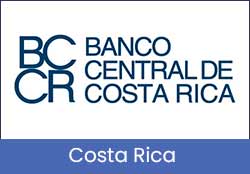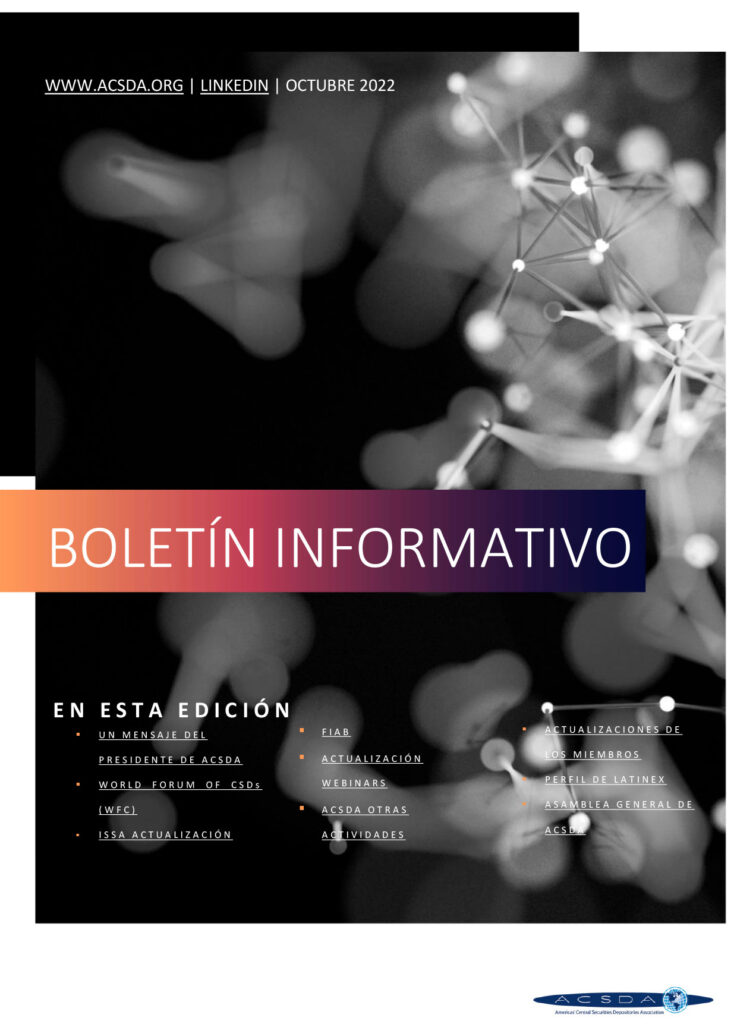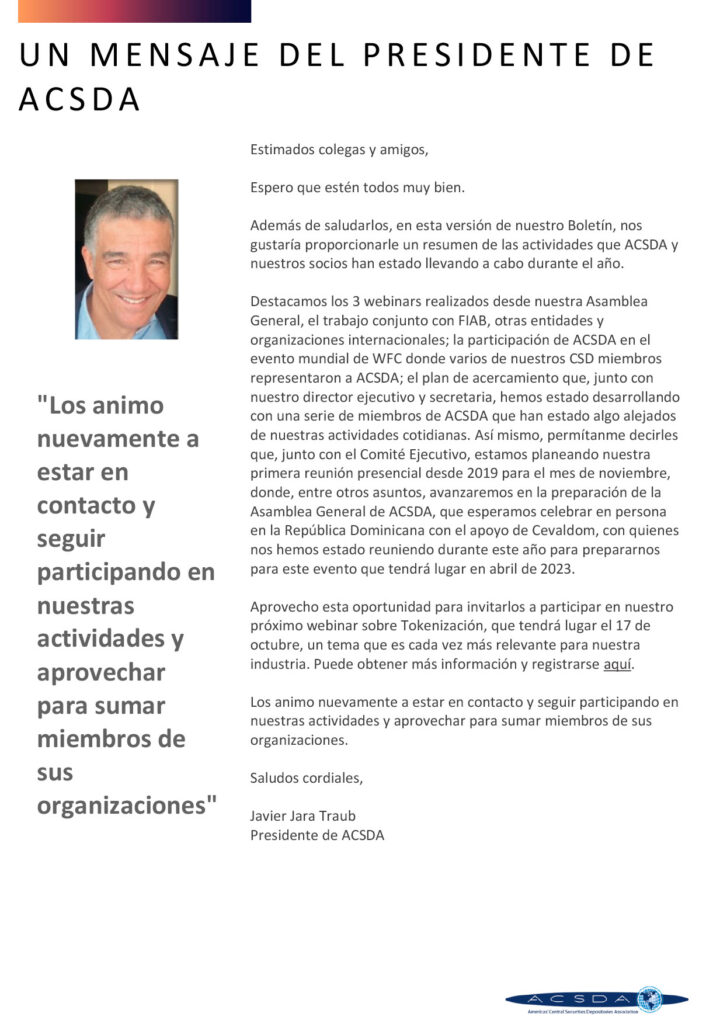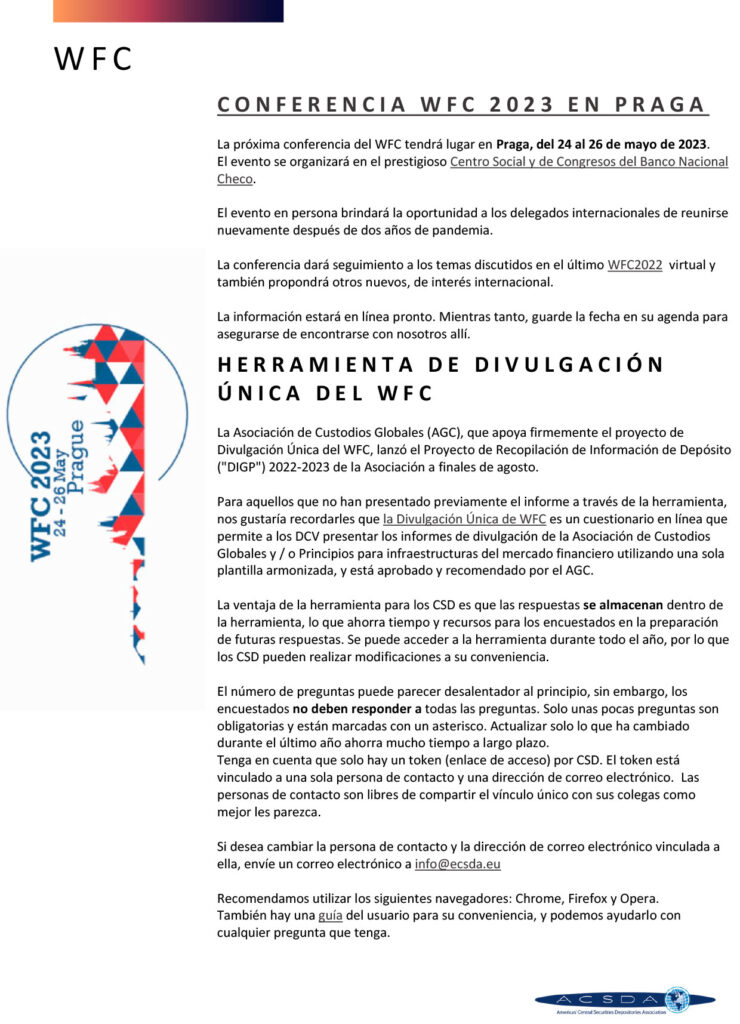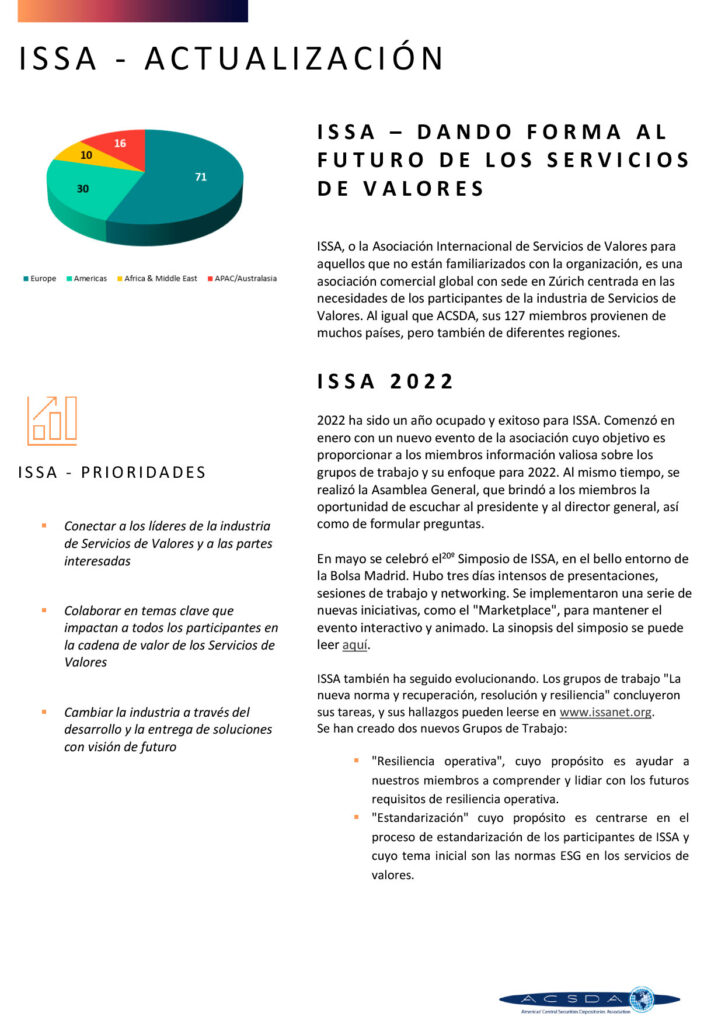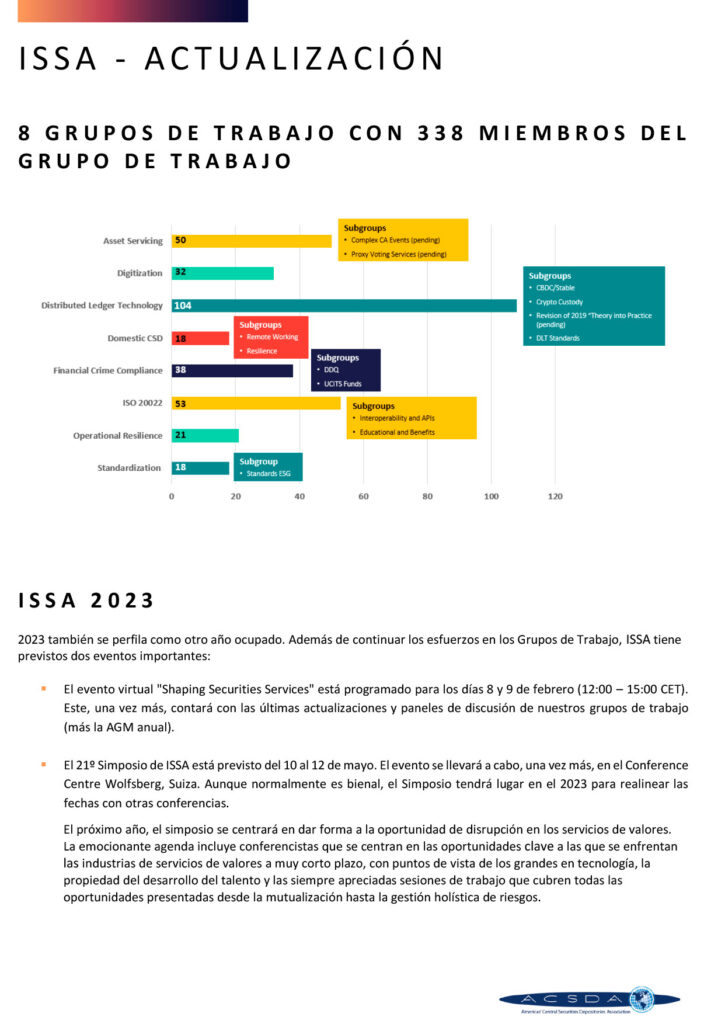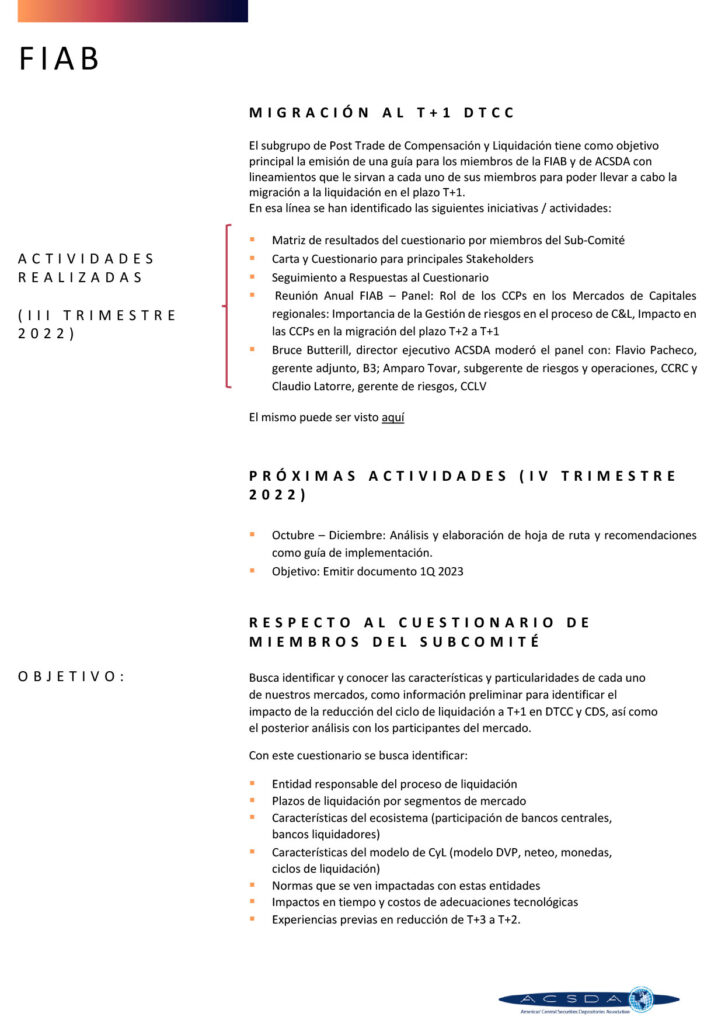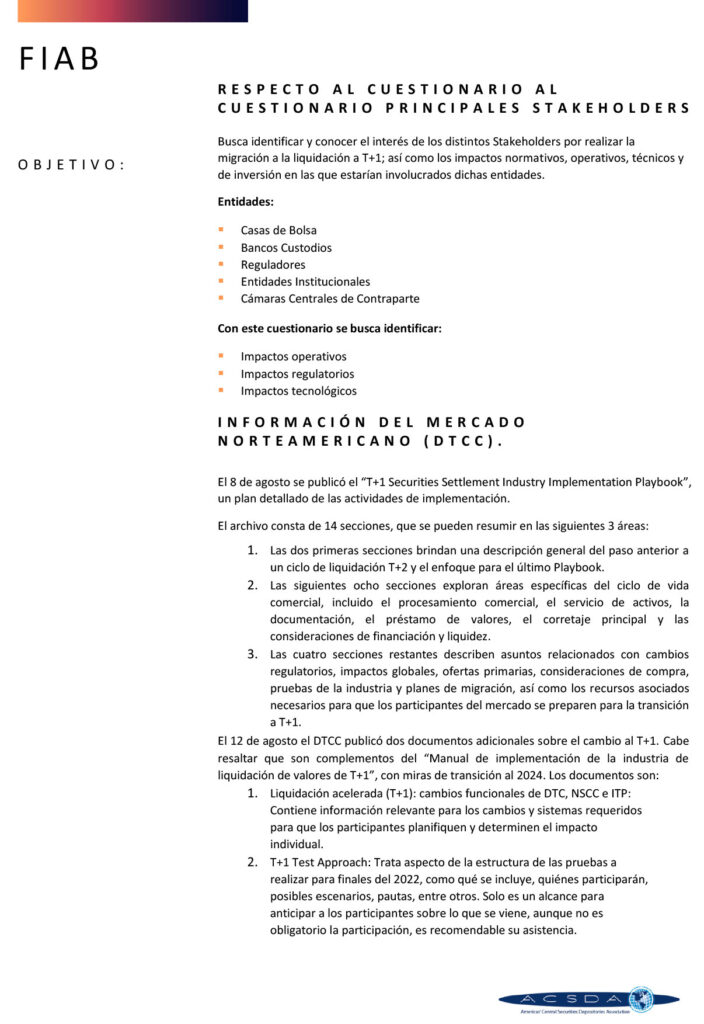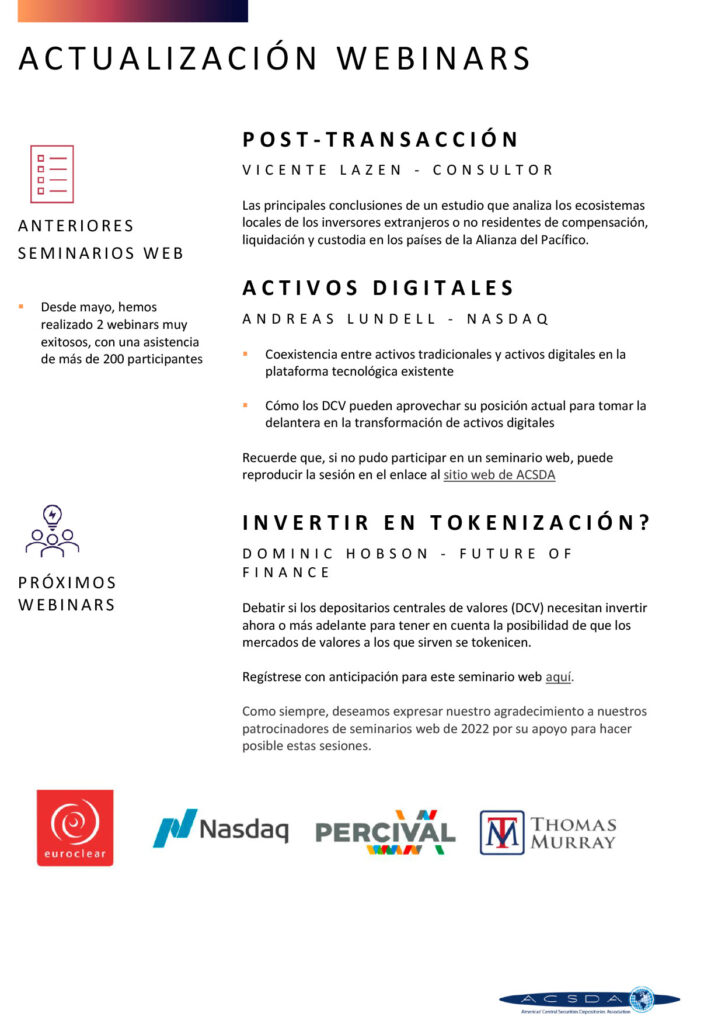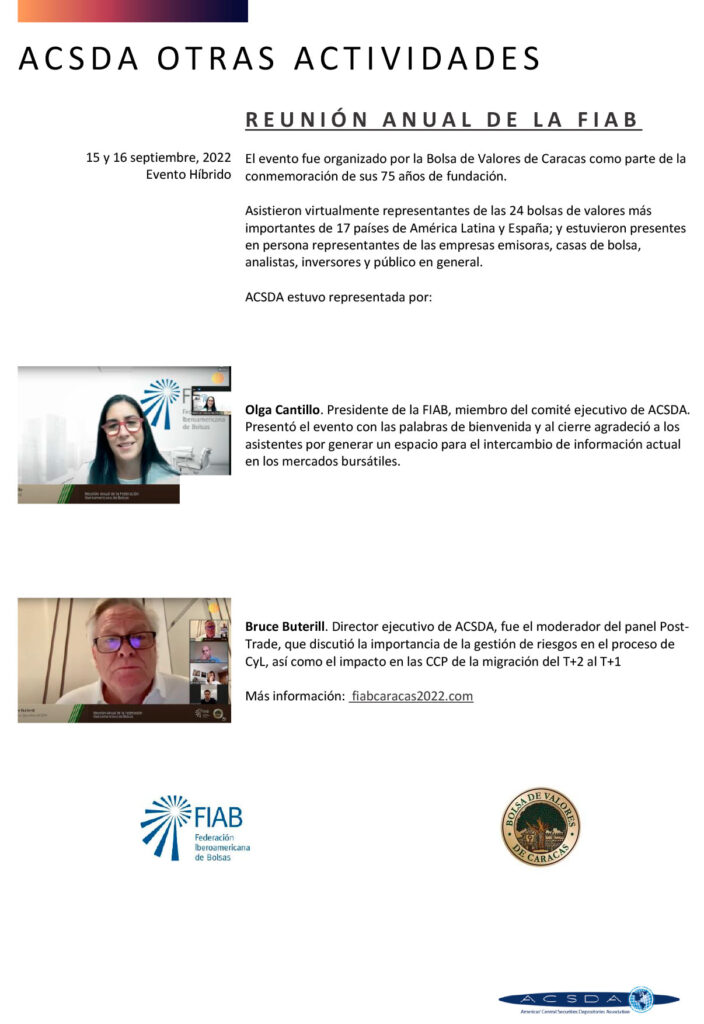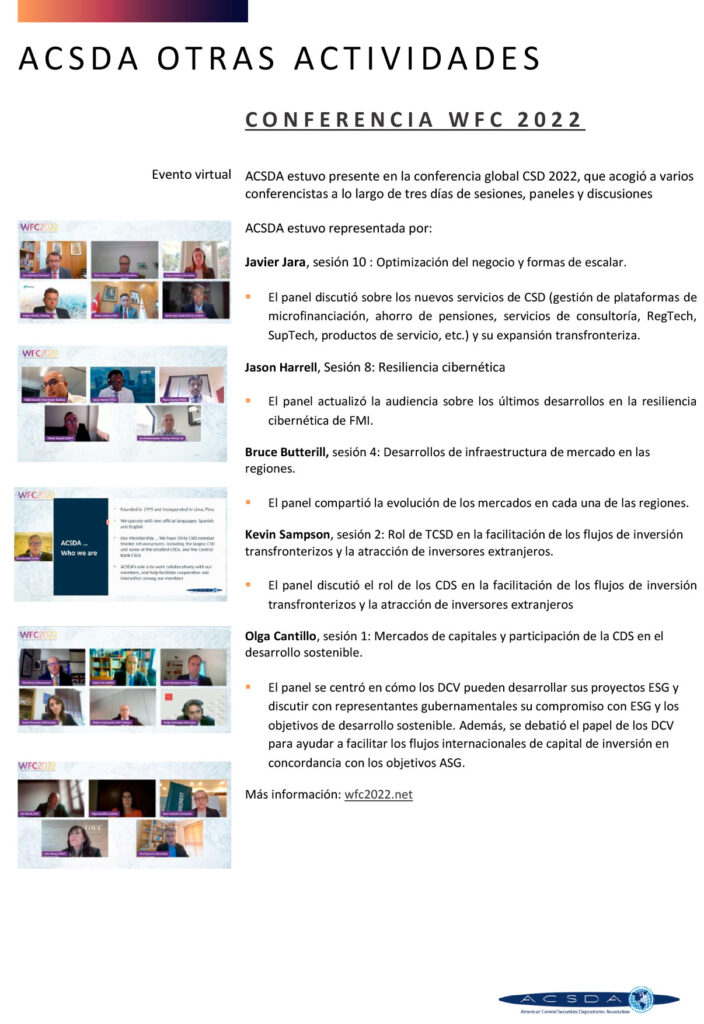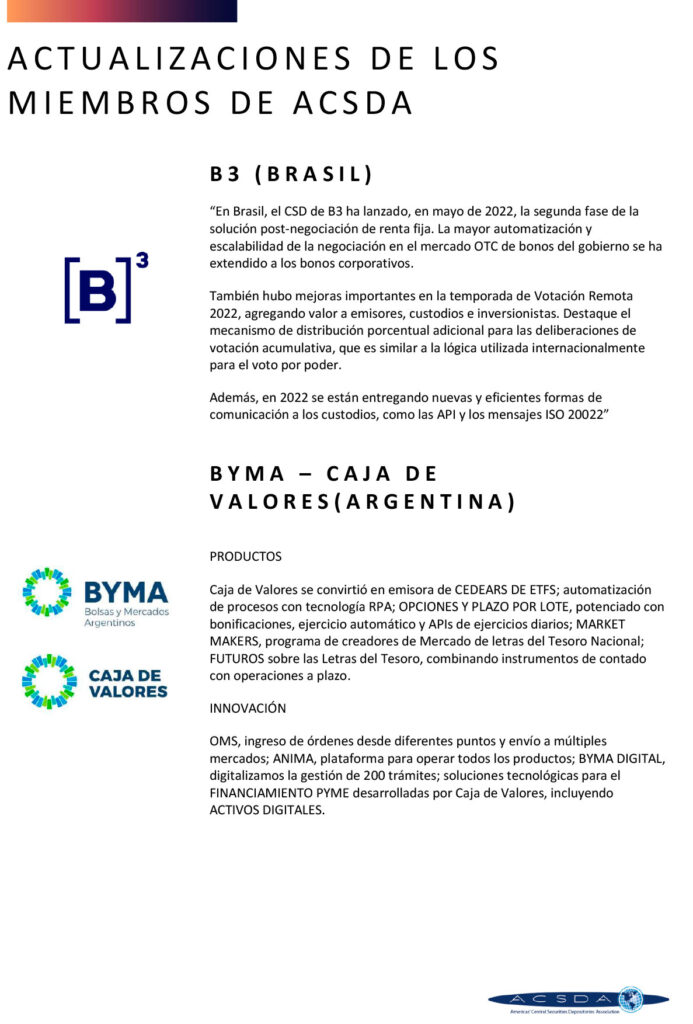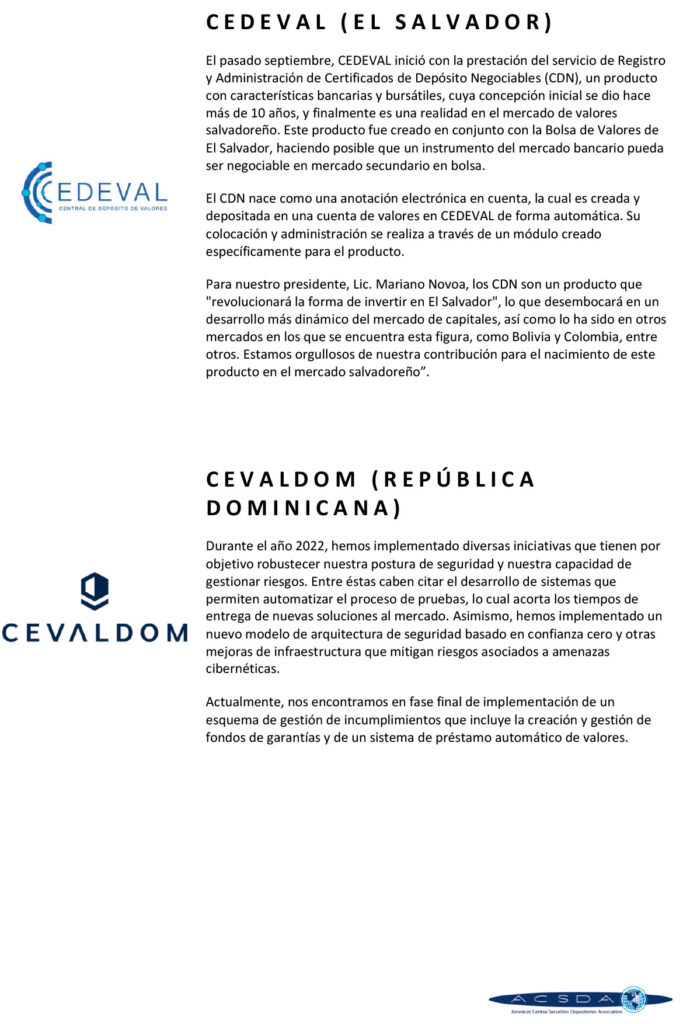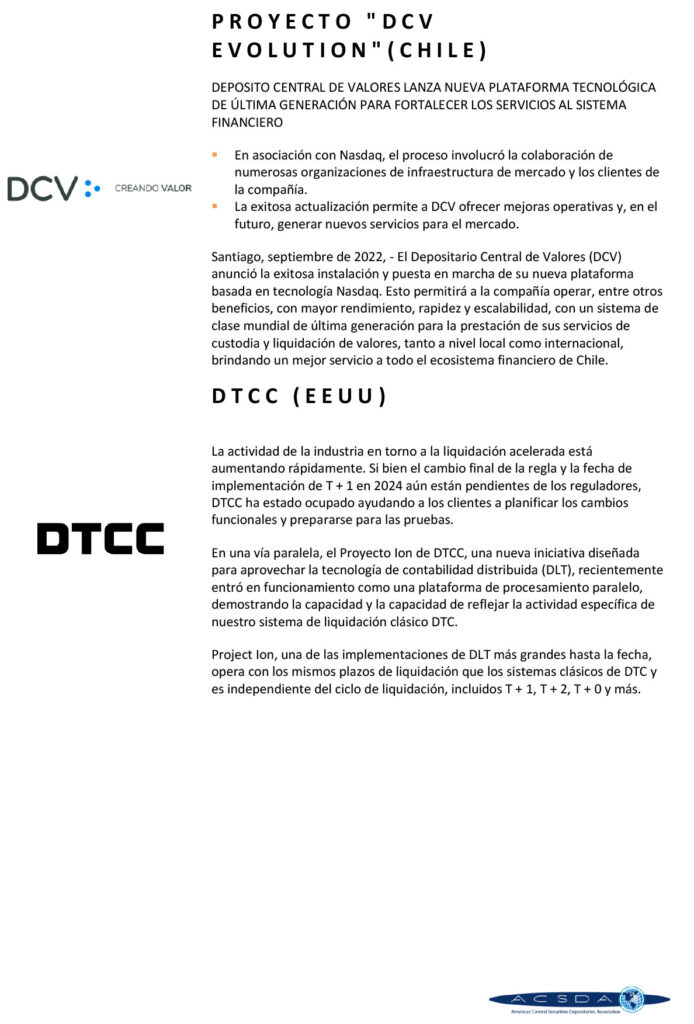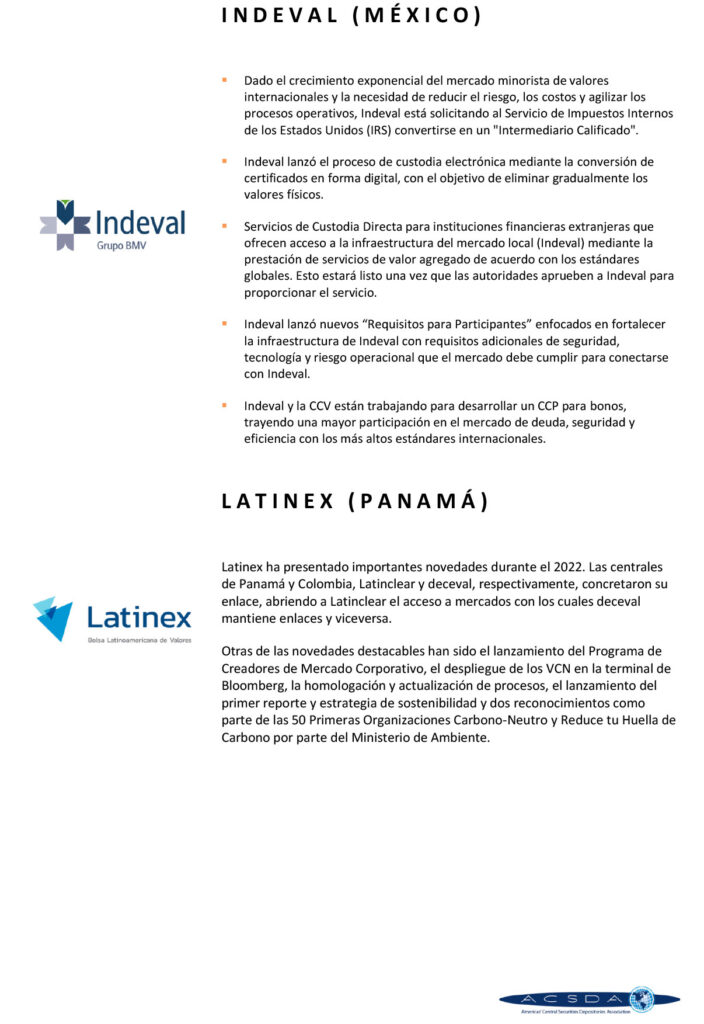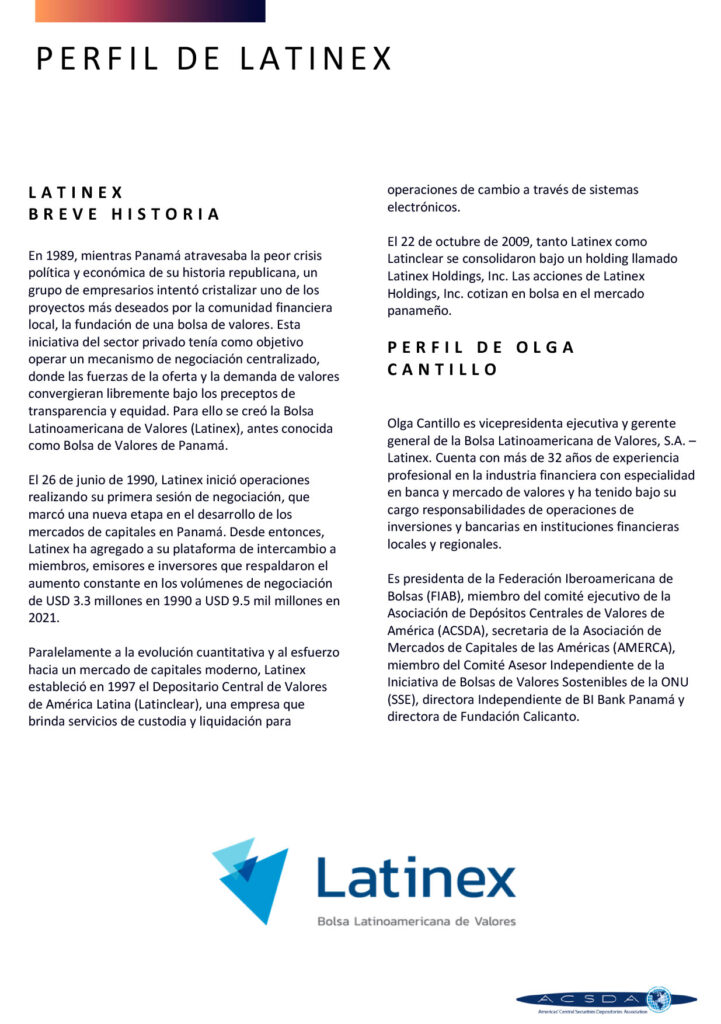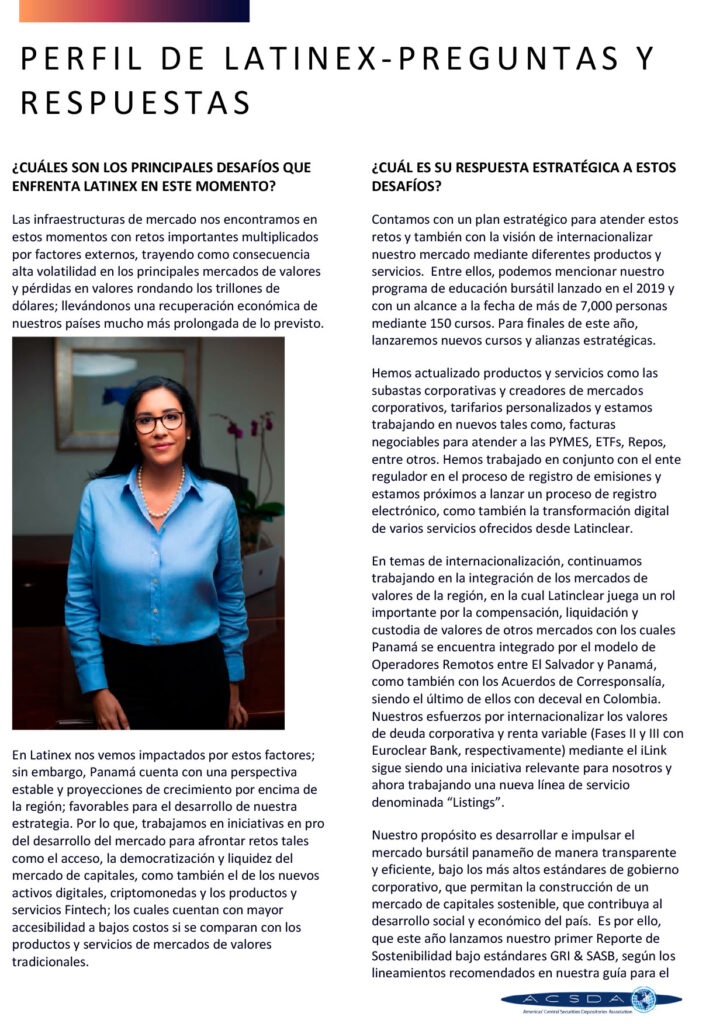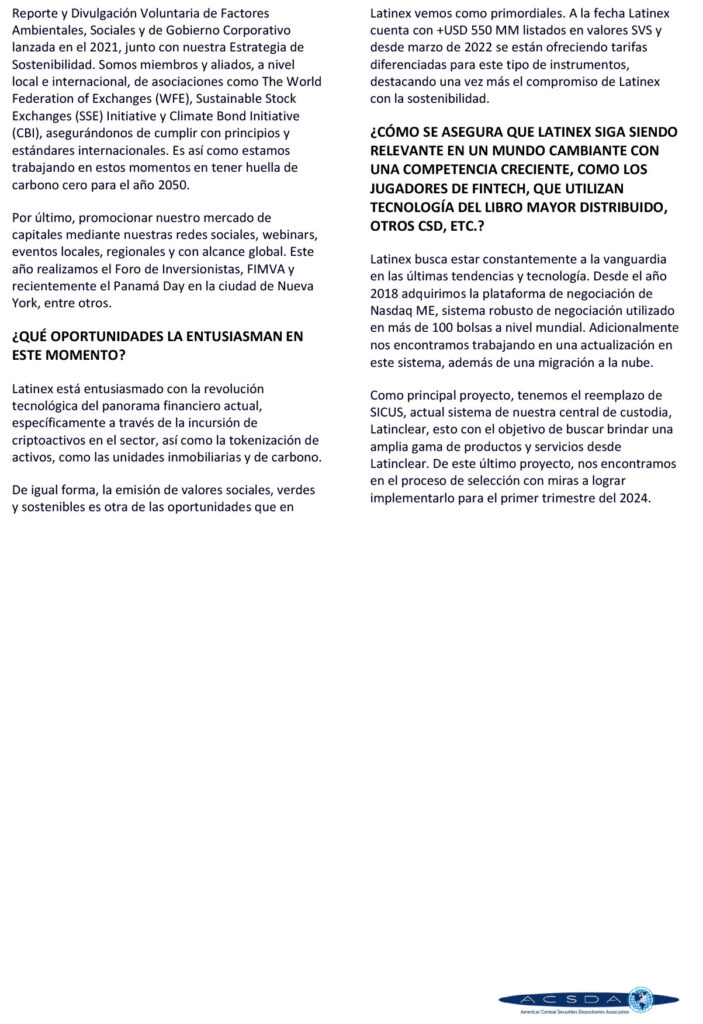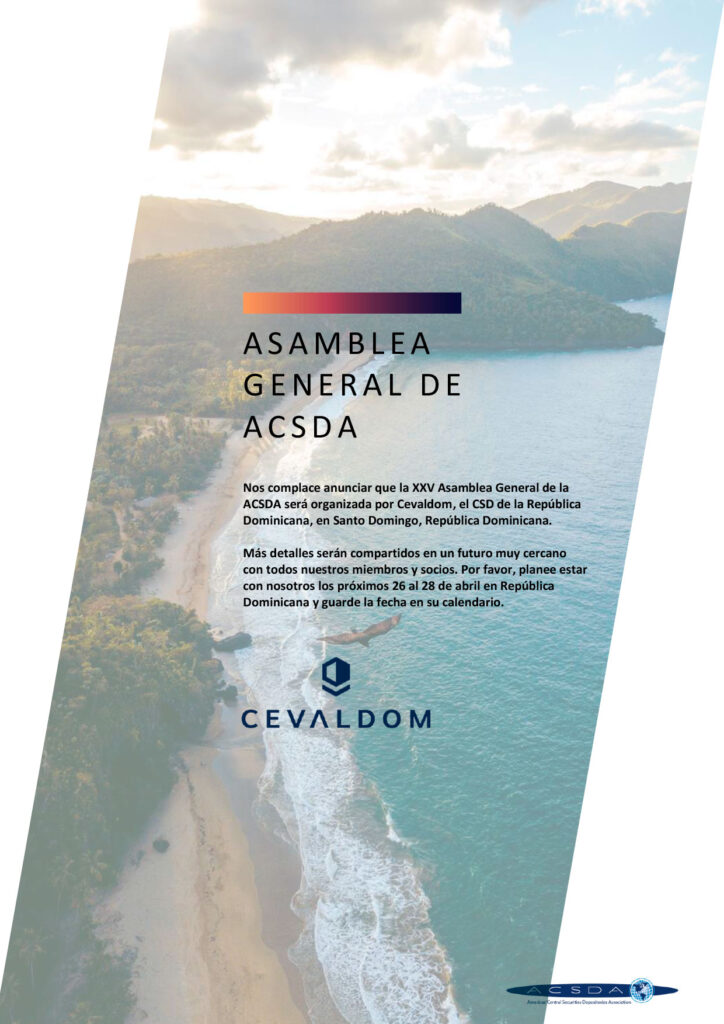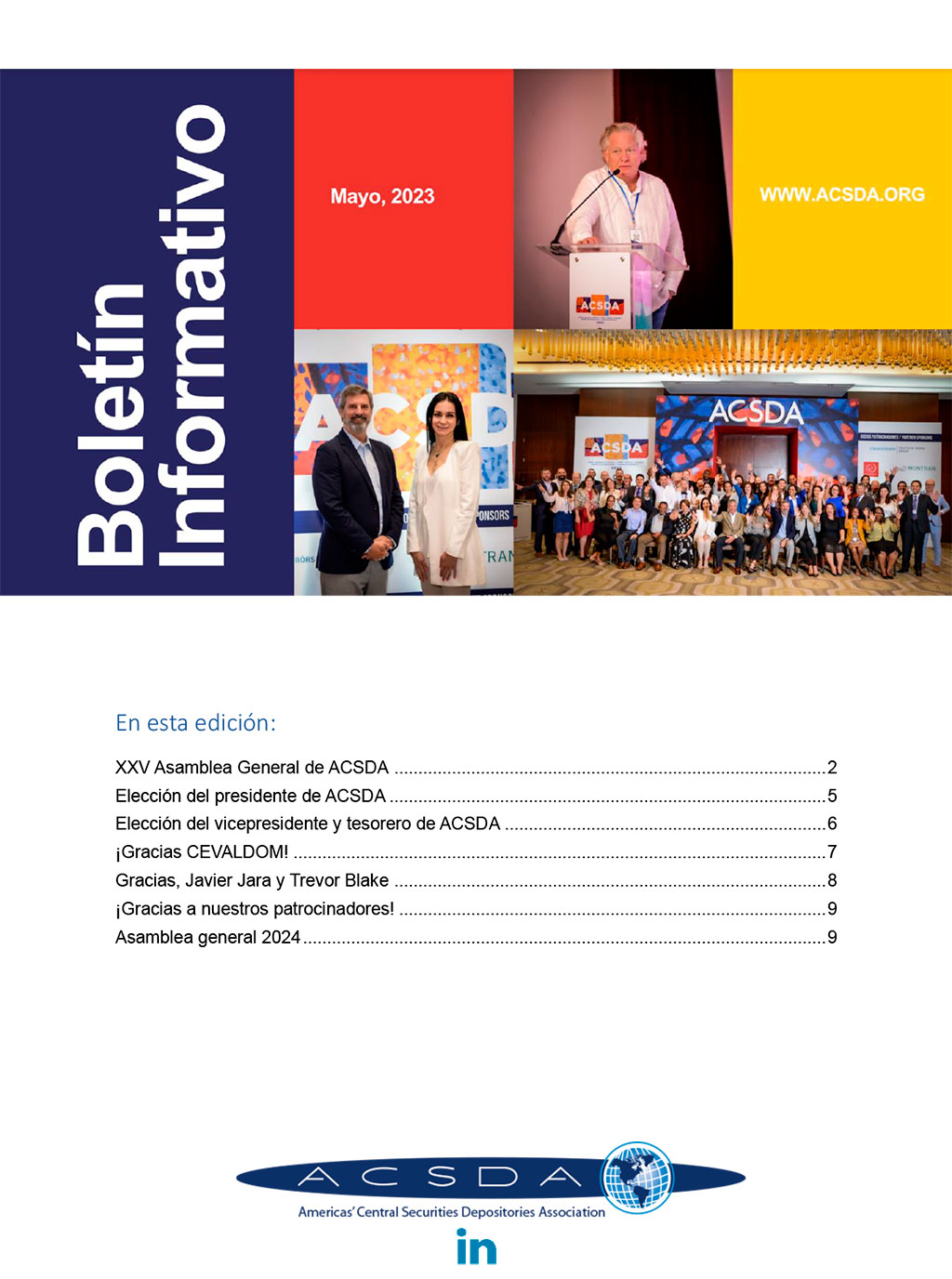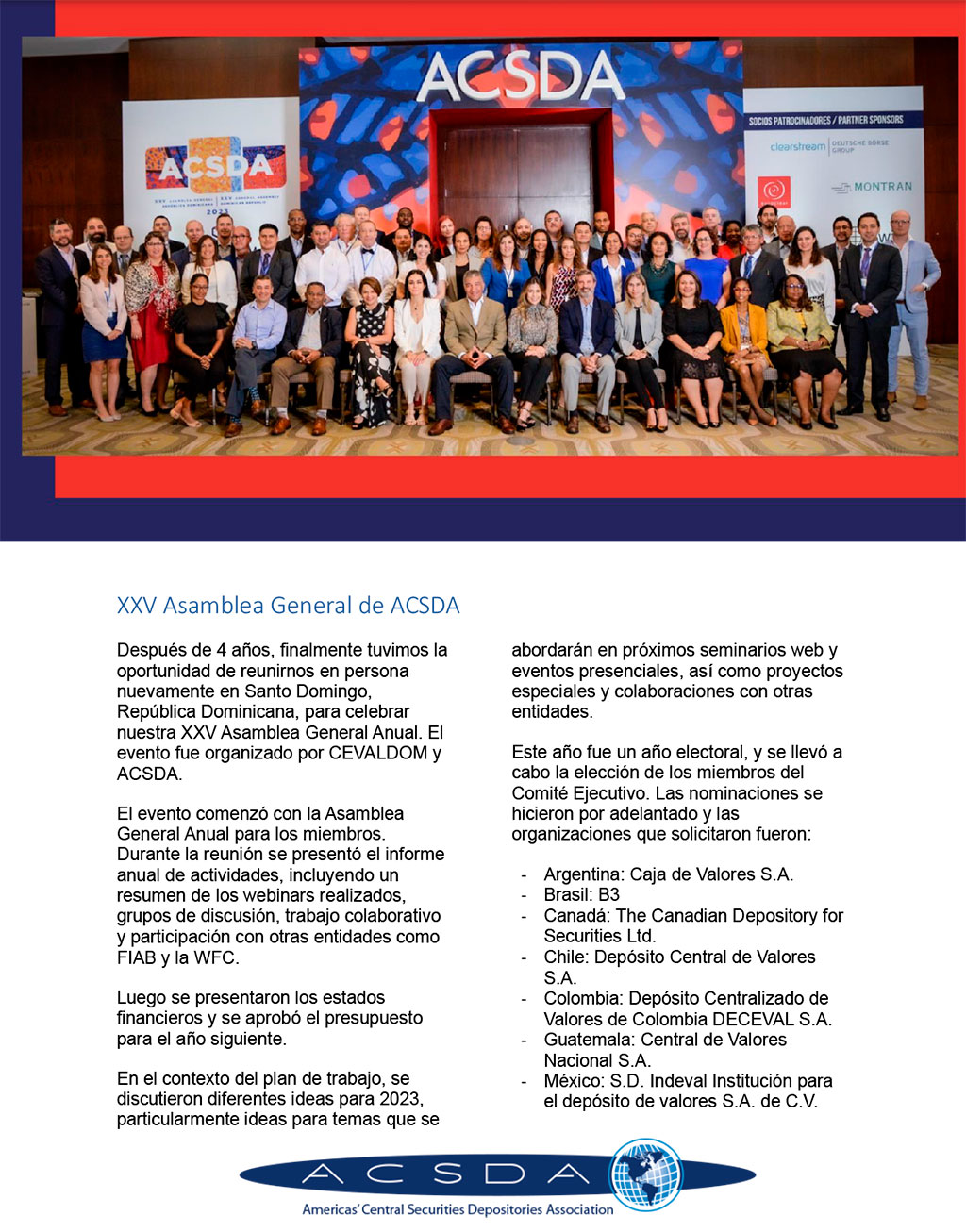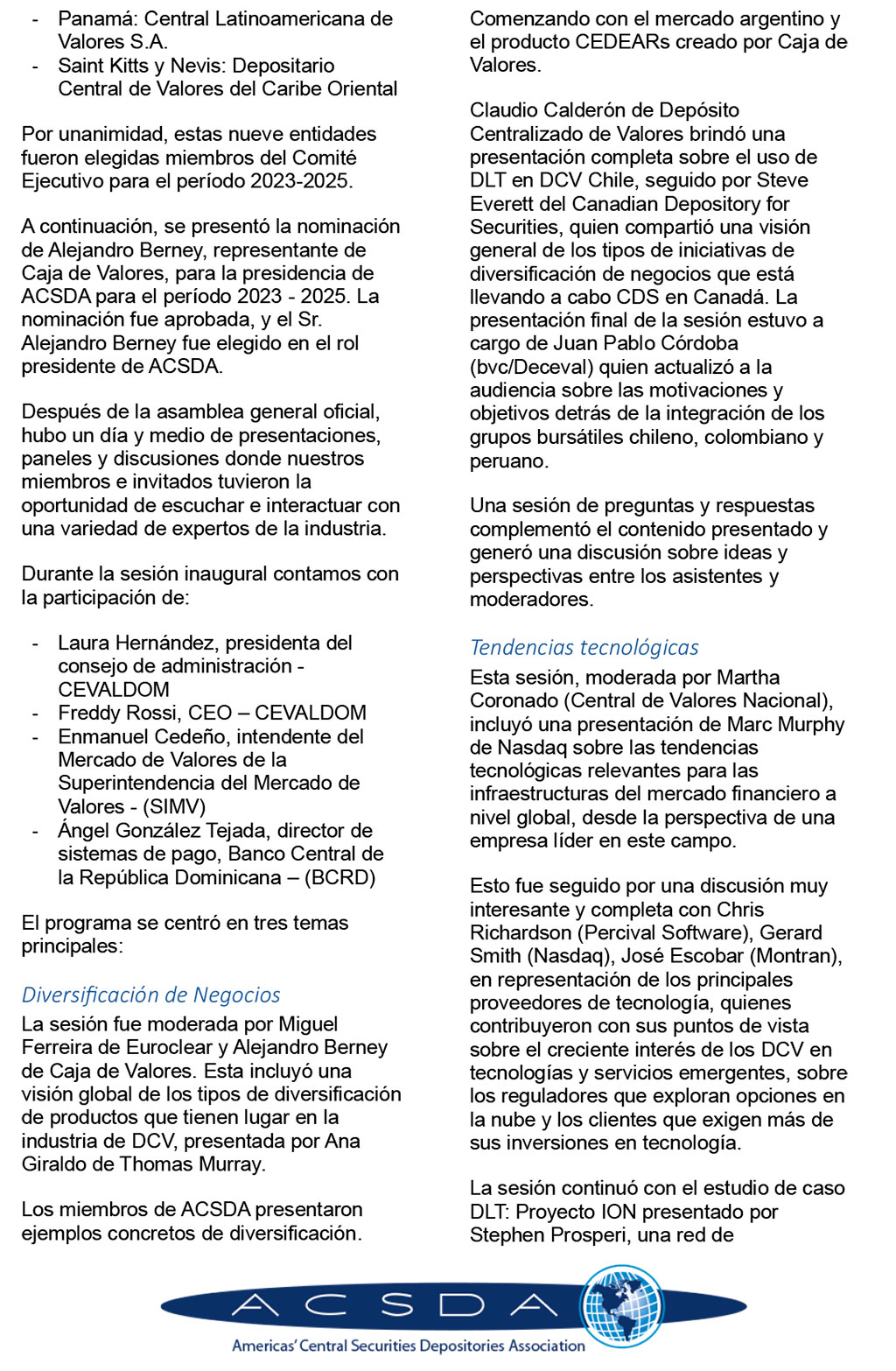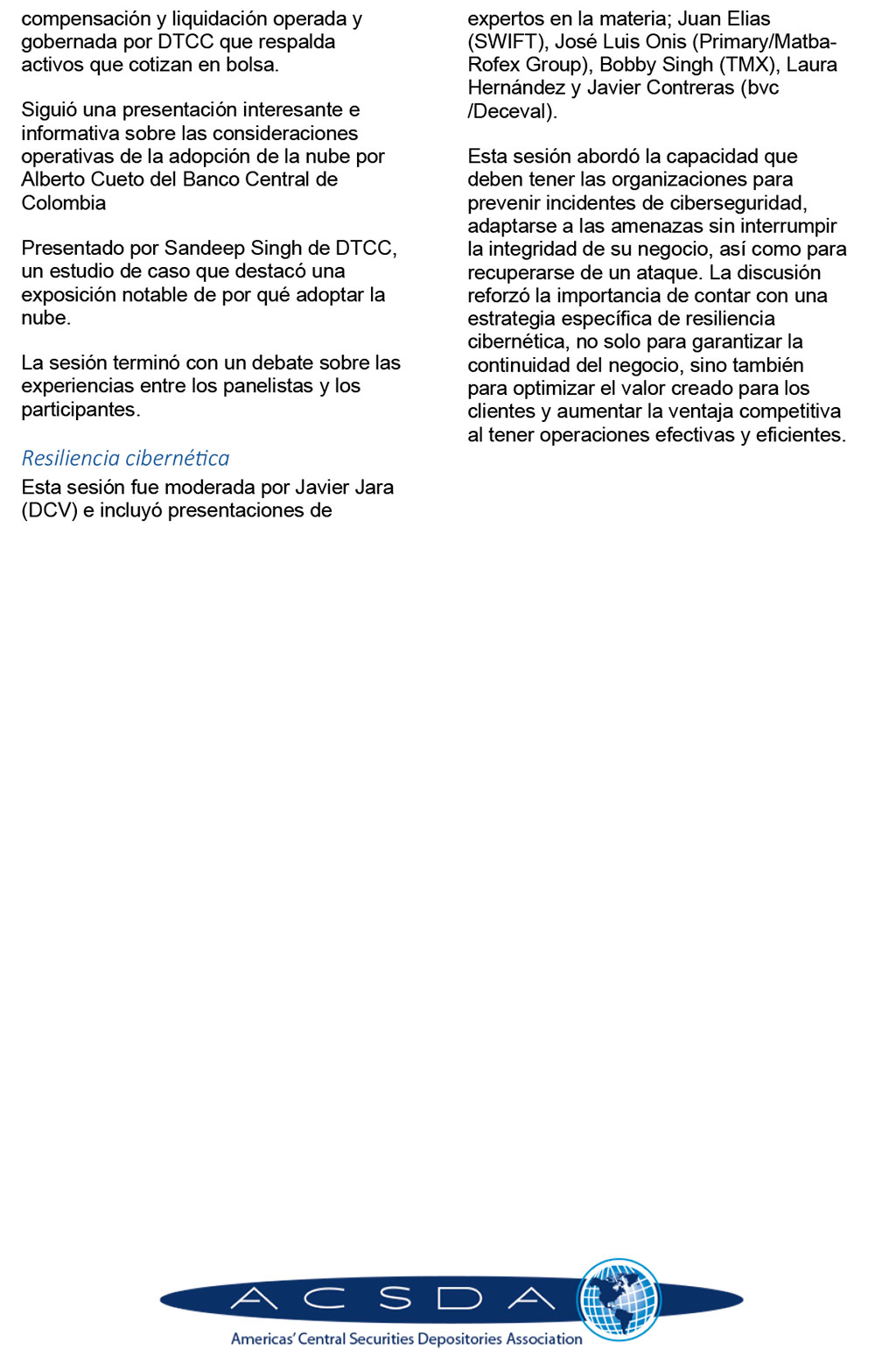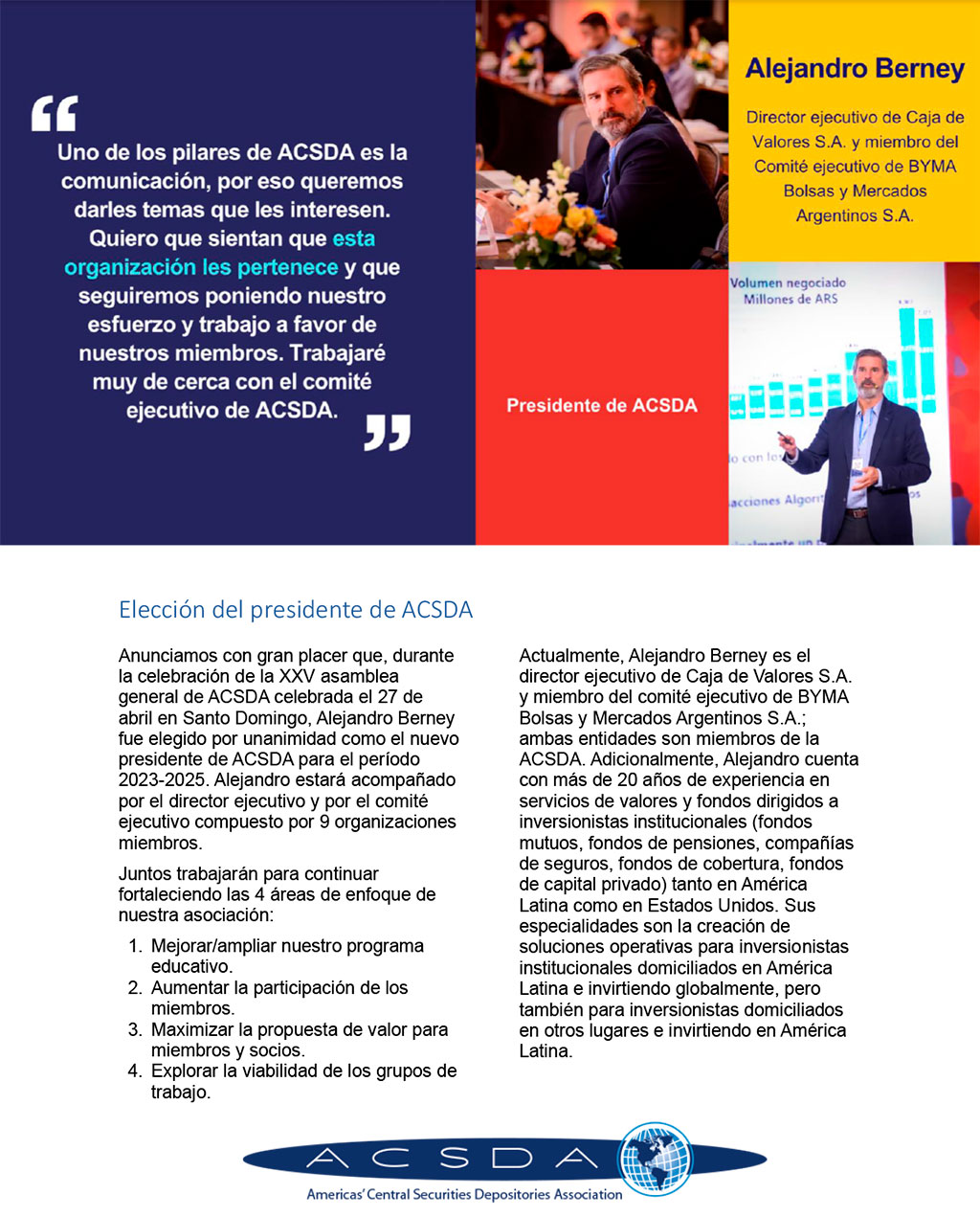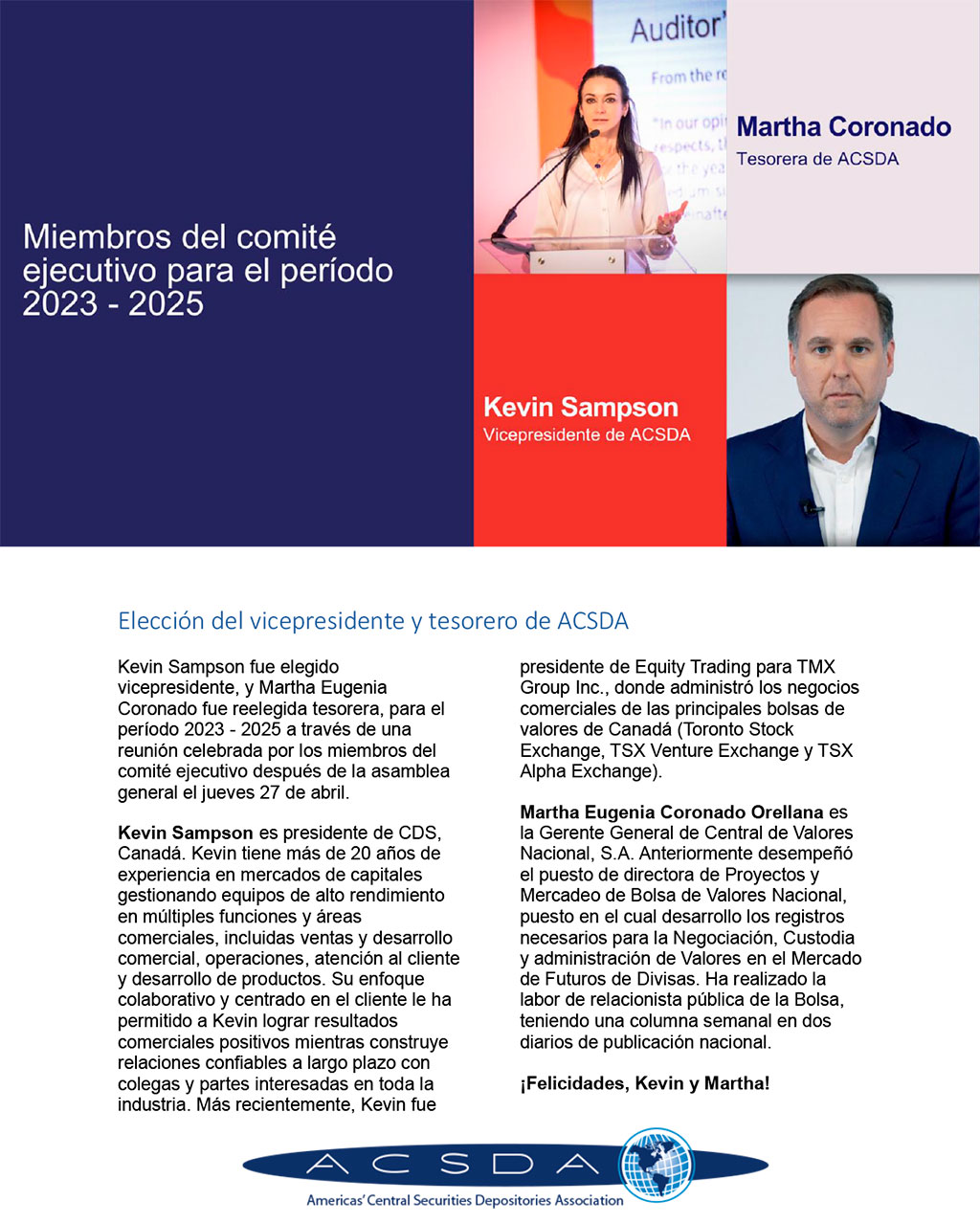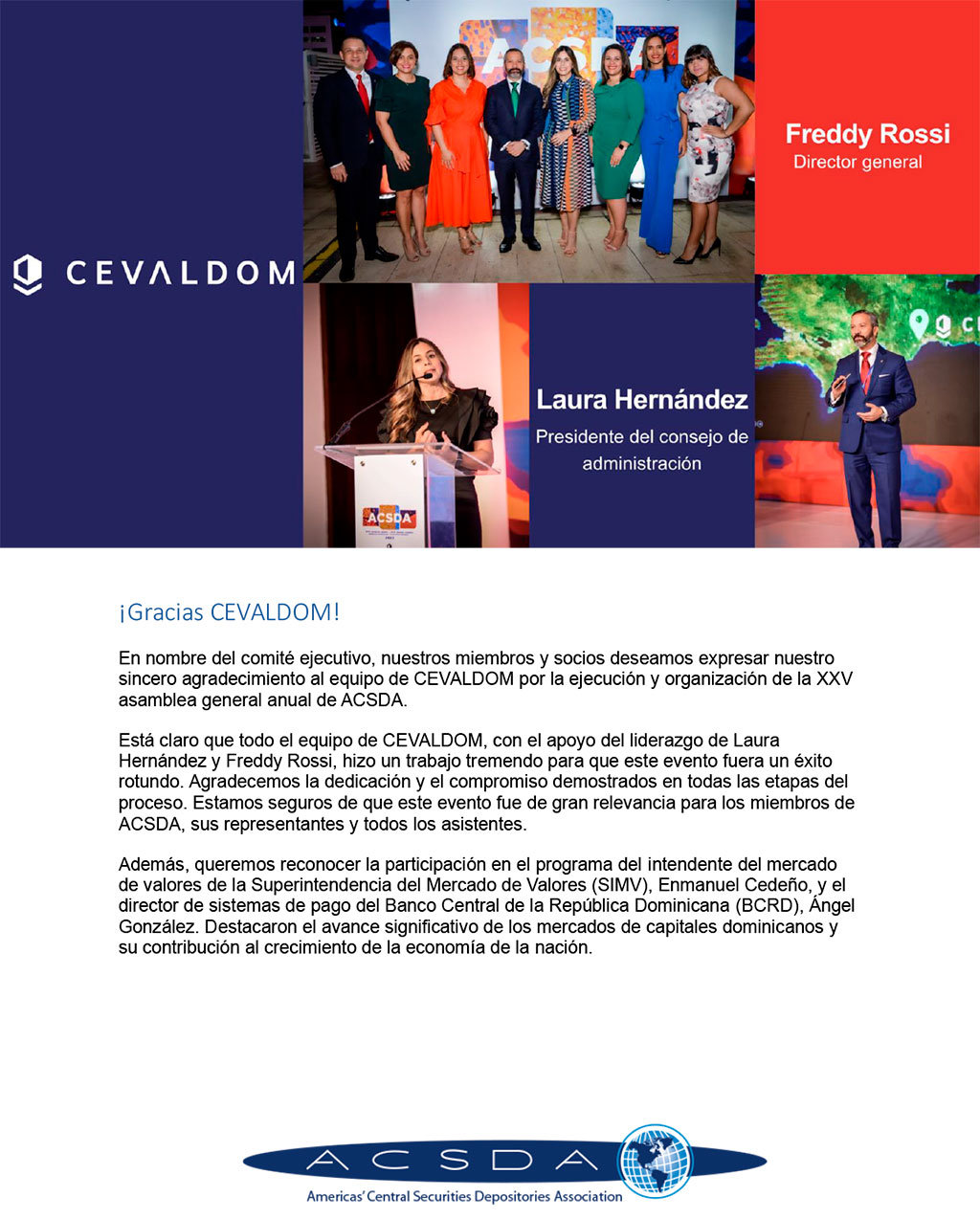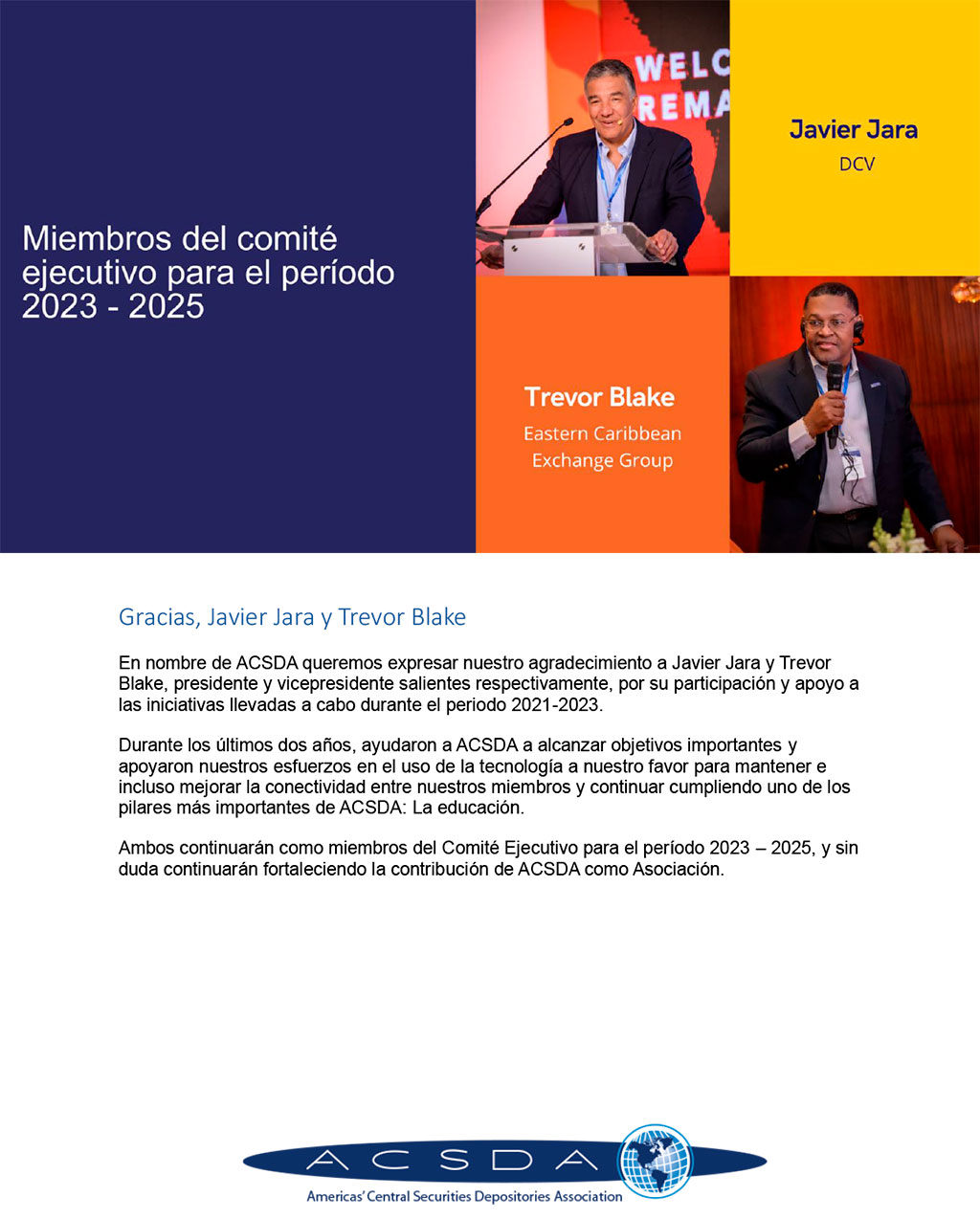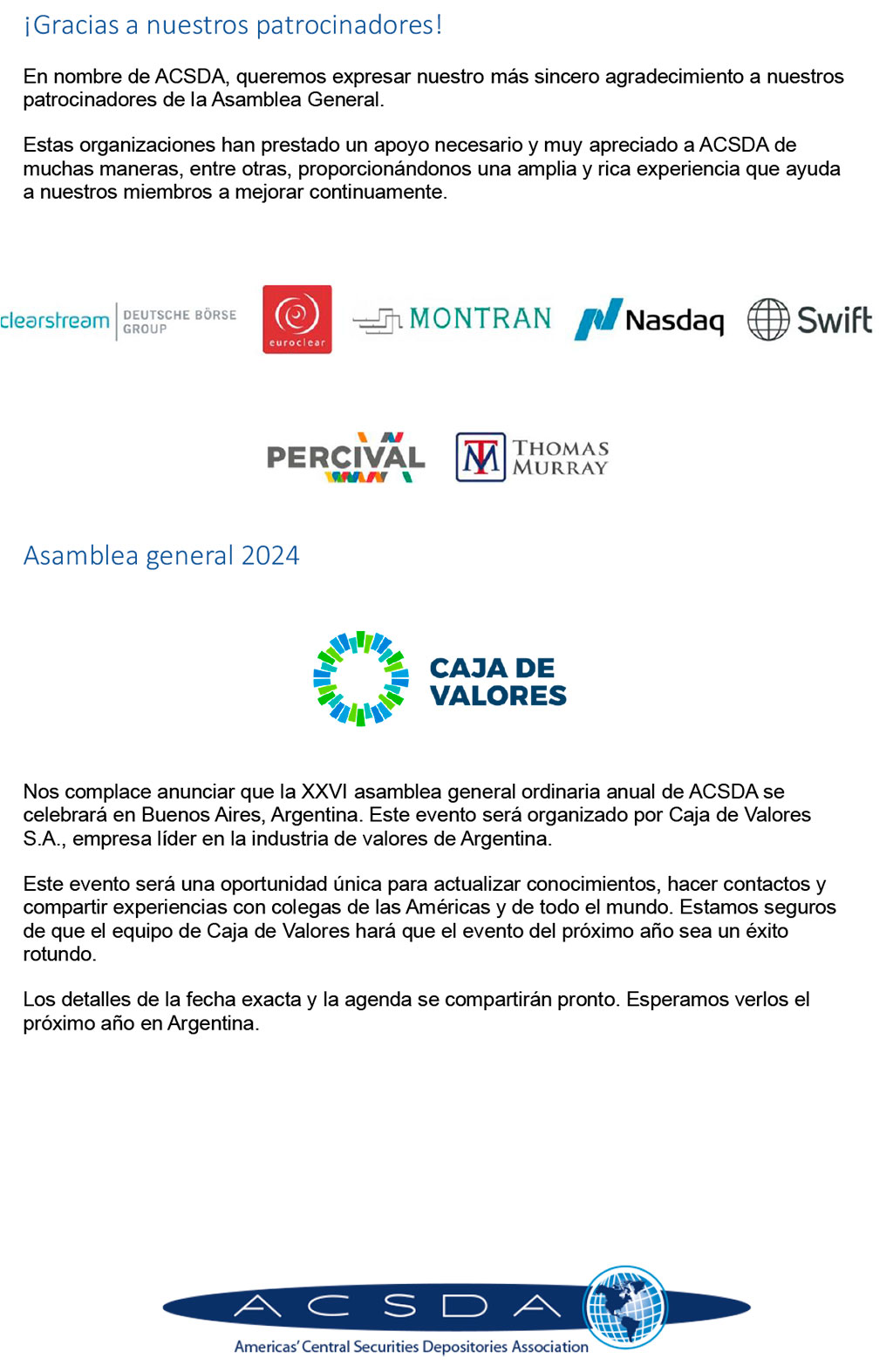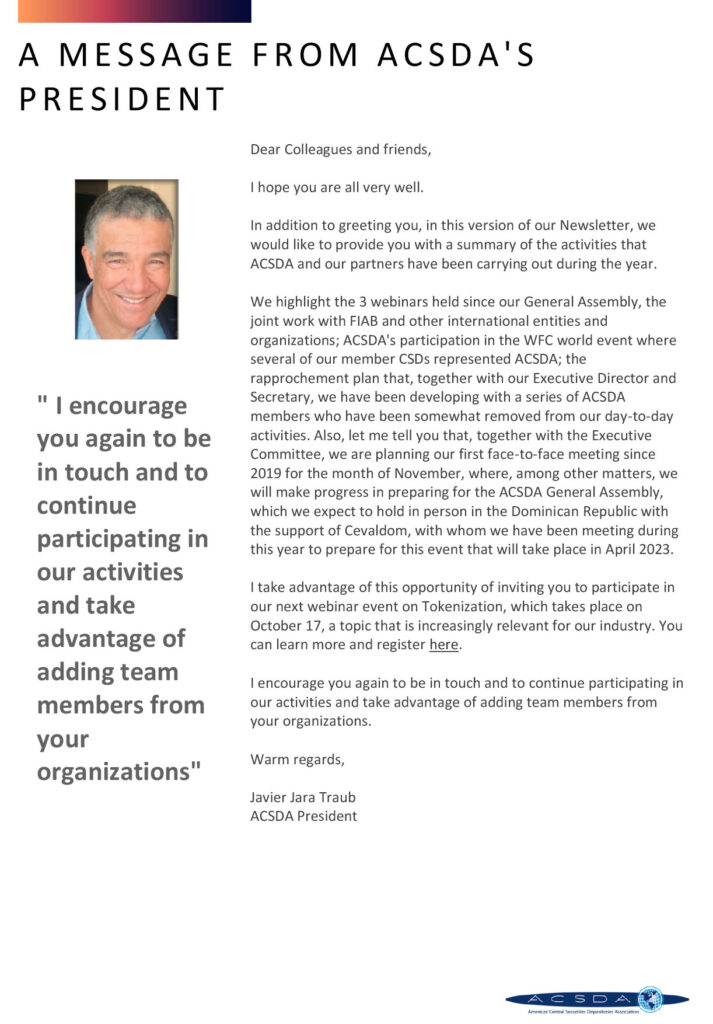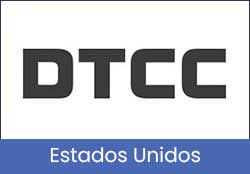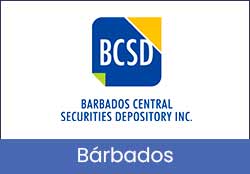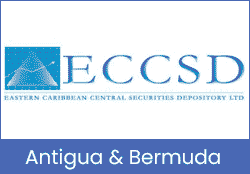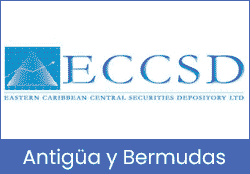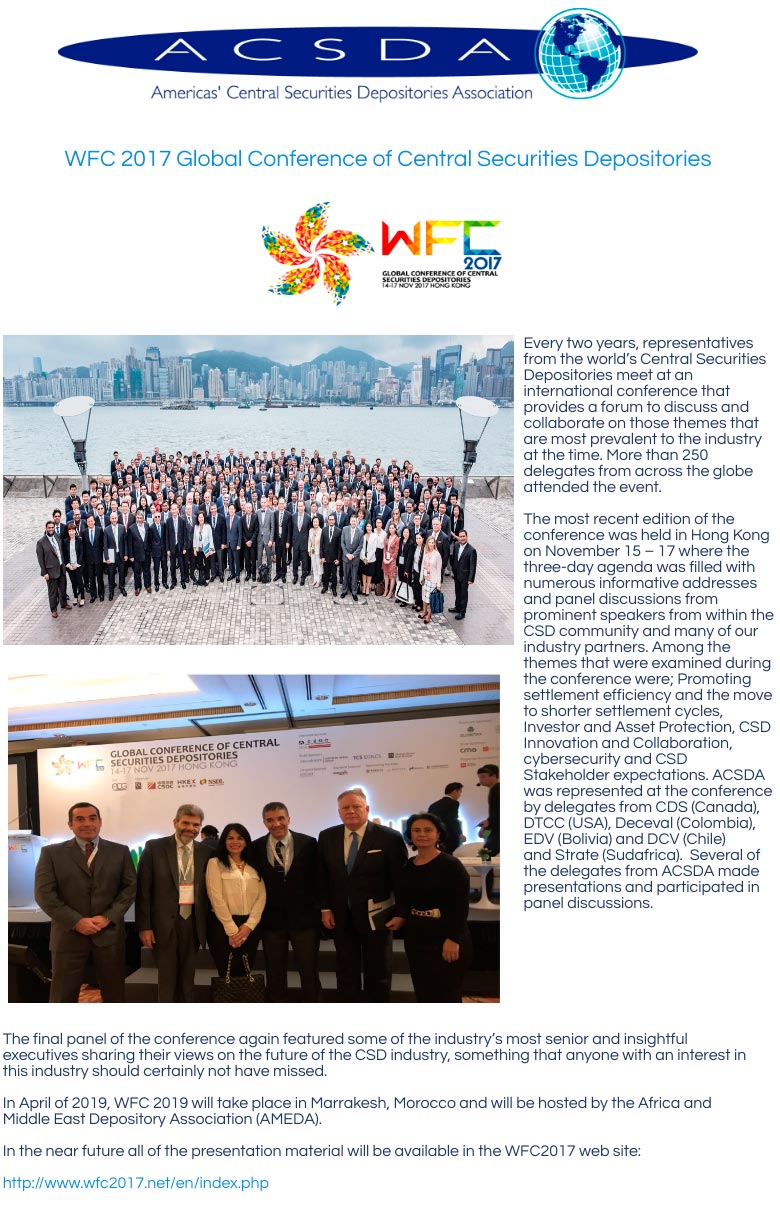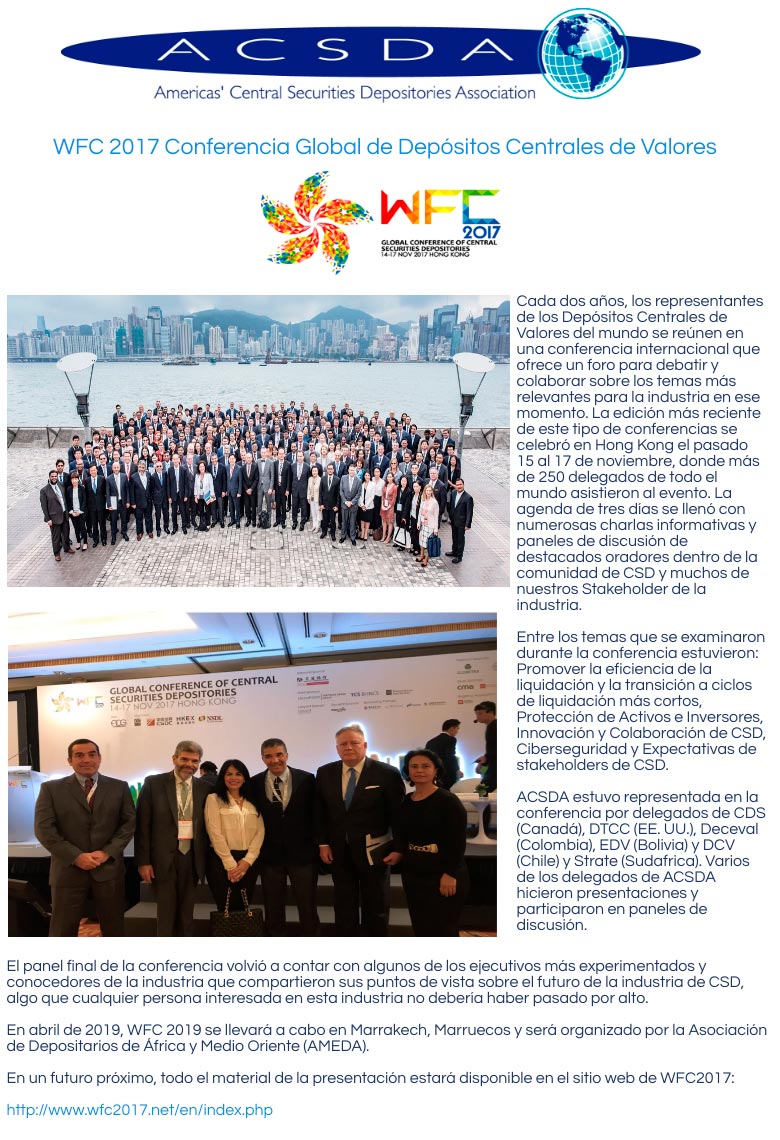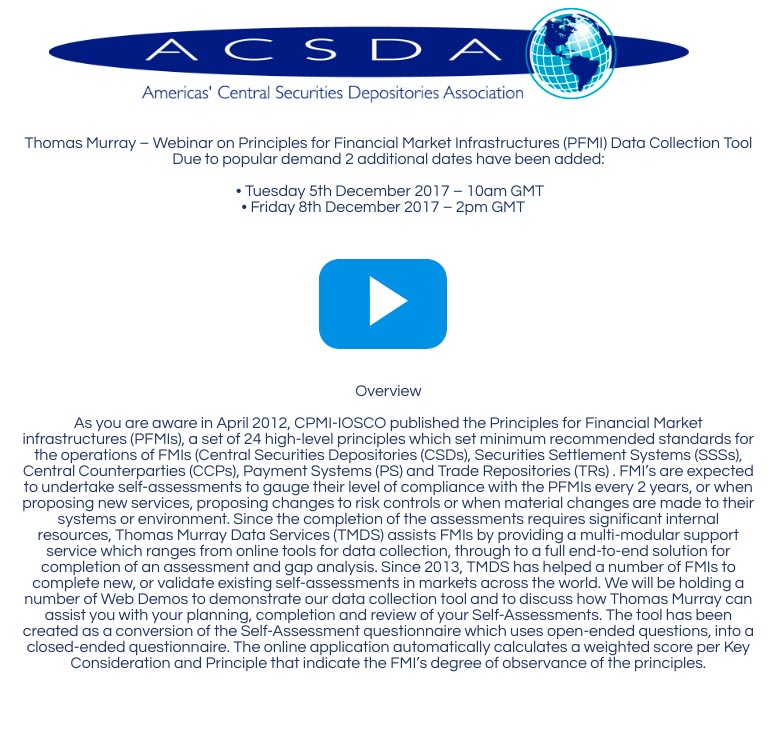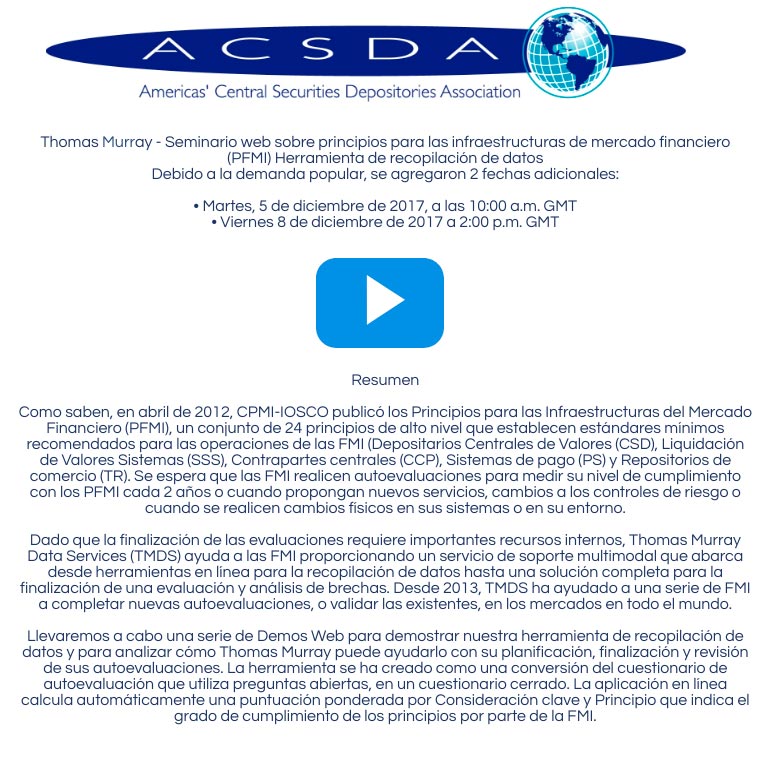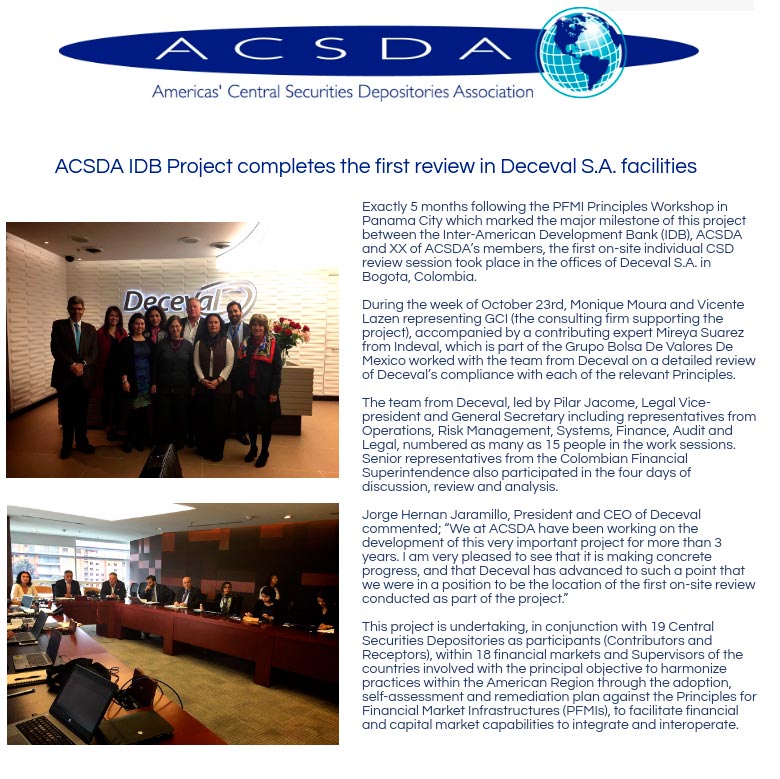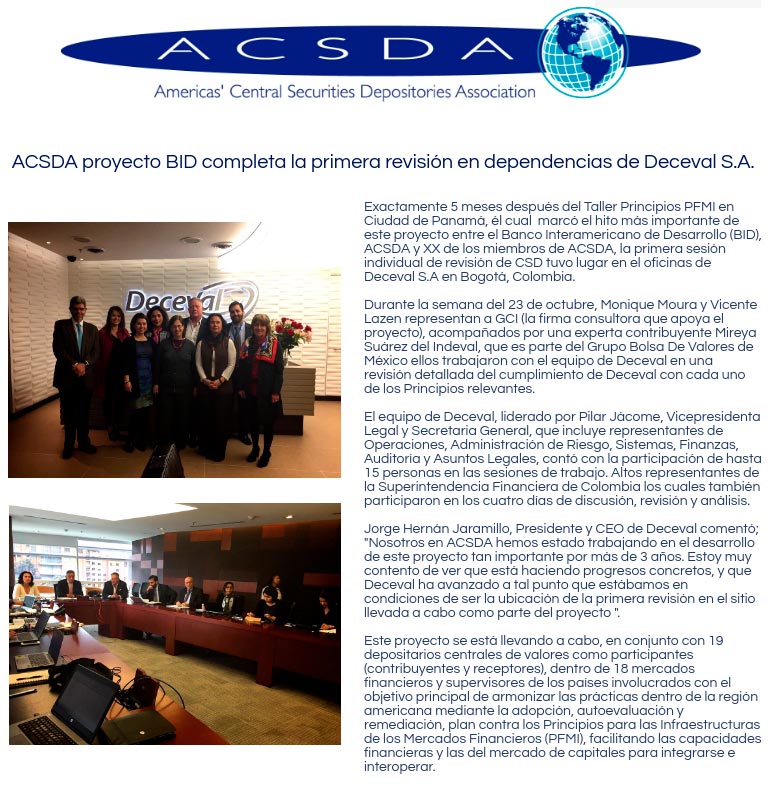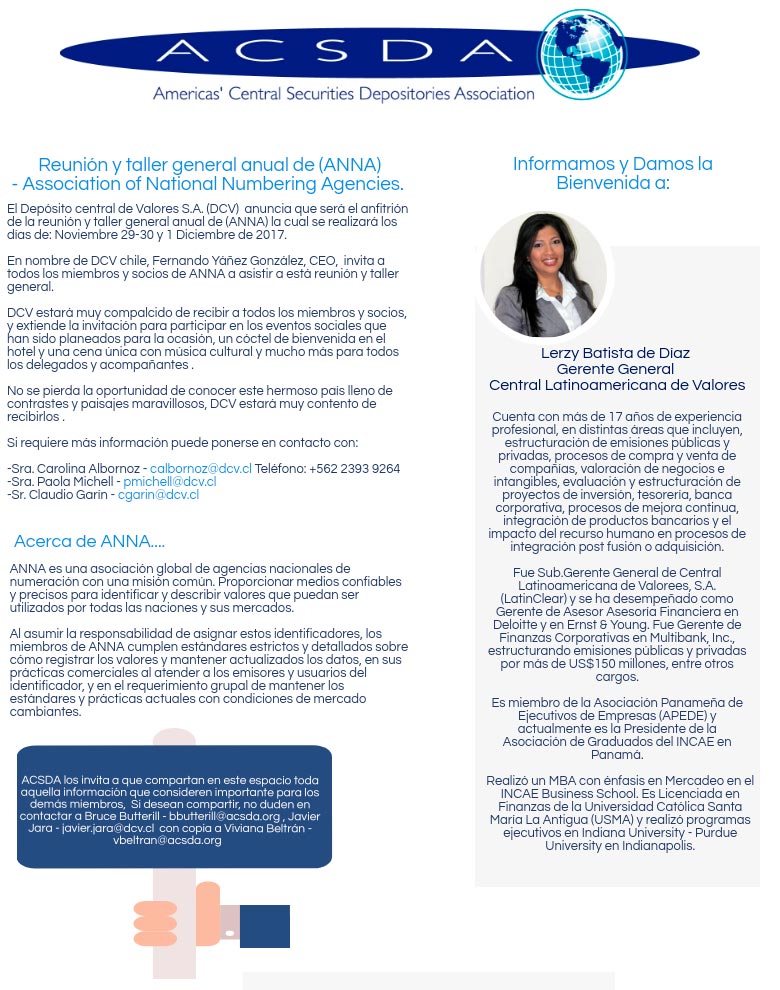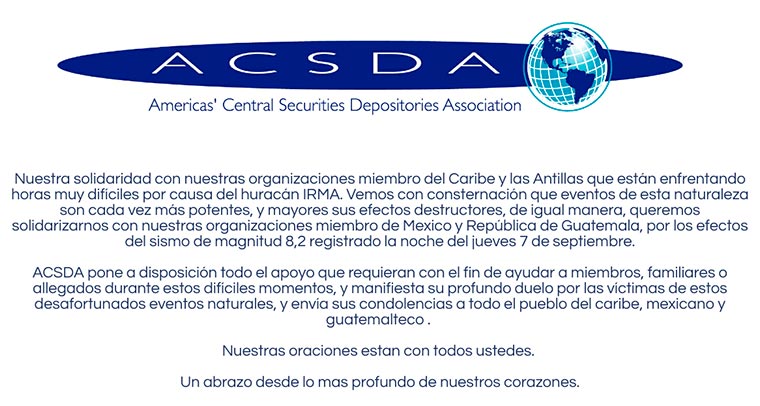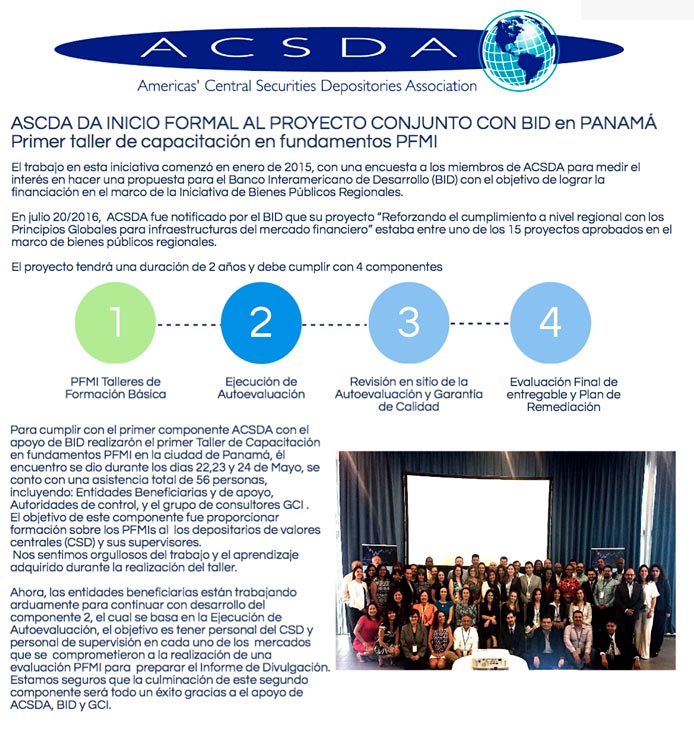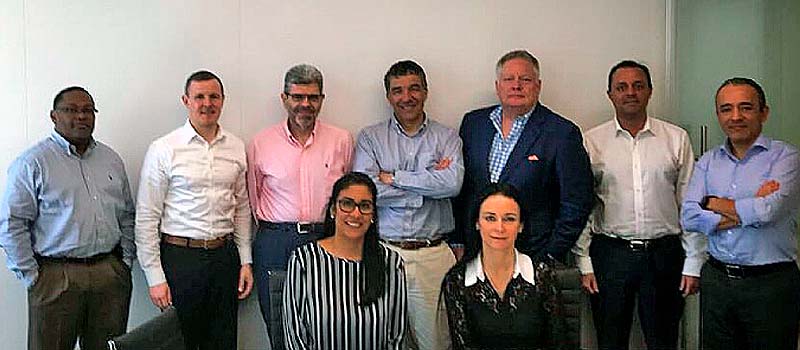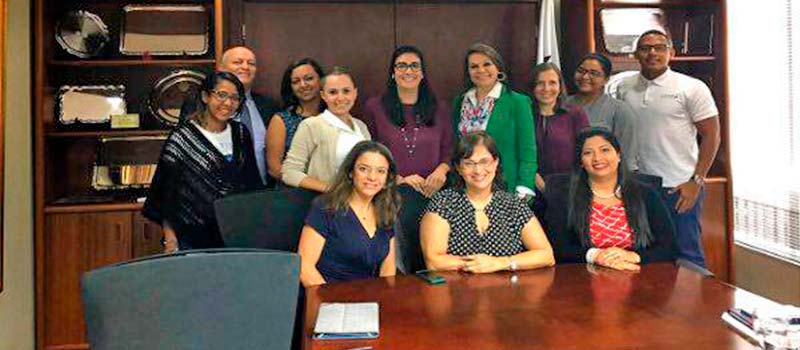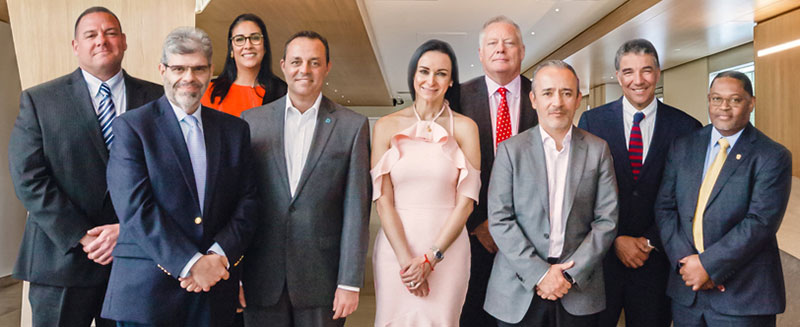Article 1 – Incorporation and Name of the Association
Pursuant to the resolution adopted in the first meeting of Central Securities Depositories
and Clearinghouses, held in the City of Lima, Peru, on August 11, 1999, the legally
incorporated Central Securities Depositories and Clearing houses of the Americas,
signatories to the Minutes of the first meeting of the Central Securities Depositories and
Clearing houses, hereby incorporate a non-profit organization to be known as “Americas’
Central Securities Depository Association”, the acronym of the association shall be ACSDA;
hereinafter referred to as “the Association” for the purposes of these Bylaws.
Article 2 – Objectives
The main purpose of the Association is to create a forum for the exchange of information
and experiences between its Members within a spirit of mutual cooperation, forming
working groups to develop and promote recommendations for best practices in services
such as securities custody, clearance, settlement, efficiency and risk management, as well
as participating in the adjustment of securities market regulations, taking into
consideration the unique characteristics of each entity, and serving as a channel to
communicate with other organizations on a global level.
In this context, the following objectives have been defined:
- Develop and recommend common standards and best practices in clearance,
settlement and securities depository services for the region and encourage the local
markets to put them into practice, with due consideration to the specific situation of
each market; - Promote efficiency and cost effectiveness in the clearance, settlement and depository
services provided in the region’s securities markets; - Provide a forum to declare best practices for clearance, settlement and depository
services, seeking market harmonization; - Cooperate with the regulatory authorities of each country to achieve best practices
related to clearance, settlement and securities depository services; - Develop recommendations for the securities market’s central processes, with due
consideration to the specific situation of each country; - Promote risk management as well as the development of sound systems for clearance,
settlement and securities depository services; - Share the experiences and information of Member organizations with the aim of
obtaining a wide range of solutions to specific topics within the ir respective markets
as well as within the context of globalization; - Foster a spirit of cooperation and integration amongst its Members in order to
promote the development and improvement of their clearance and settlement systems
for the mutual benefit of their participants; - Establish committees, whether permanent or temporary, to co-ordinate tasks and
carry out the basic activities of the Association in accordance with its objectives,
especially those whose goals are to establish common points of view with respect to
clearance, settlement and securities depository services.. Such committees are to be
established by the General Assembly and/or the Executive Committee. The Association
shall have at least a Working Committee; and - Develop channels for dialogue with other organizations when deemed appropriate.
Article 3 – Legal Authority
The Association will have the legal authority required for the undertaking of its corporate
purpose, in accordance with the laws of the country where its headquarters are located.
The Association, acting through the Executive Committee, may carry out all kinds of
functions and enter into all kinds of contracts, such as the following:
- Purchase, sell, transfer and register any and all movable and immovable property,
whether tangible or intangible; - Lease and lease out movable and immovable property for the term deemed
appropriate; - Execute all kinds of agreements and contracts, whether with public or private entities,
national or international, including banking transactions with private or public
institutions in any country in the world; - Grant and receive donations, to or from legally recognized entities, with or without
charge; and - Grant proxies and issue general or special powers of attorney. and revoke them.
It is hereby noted that the above listing is merely for enunciation purposes. In the event
that transactions contemplated in Points 1, 2, 3, and 4 of the preceding paragraph require a
payment over an amount which shall be determined annually by the General Assembly, it
shall be necessary to obtain the approval of at least two thirds (2/3) of the attending or
properly represented votes at an Ordinary or Extraordinary Assembly that should be
convened for such purpose.
The Association shall in any event, inform each and every one of its Members within a
period of fifteen (15) days, of any agreement or contract that it has executed.
In addition, the Association shall not take any action or endorse any position that might be
detrimental to any of its Members. An agreed upon exclusion not be considered a detriment
pursuant to these Bylaws.
Finally, the Association shall not have the legal authority nor the legal capacity to bind any
of its Members to third parties. In addition, the Association, as a legal entity, assumes full
legal responsibility for the actions it takes under these Bylaws, without being able to
endorse any individual responsibility against any of its Members.
Article 4 – Duration and Headquarters
The Association is established for an indefinite period of time and it shall be registered
under the laws in effect in Peru. These Bylaws and the Association itself, shall be subject to
Peruvian legislation and laws.
The permanent headquarters of the Association shall be in the city of Lima, Peru. However,
the Association’s headquarters may be changed to a different location deemed convenient
by a decision of the General Assembly, adopted by the quorum prescribed in Article 11 of
these Bylaws but with the restriction that it must always remain within the geographic area
of the American continent.
Article 5 – Official Language
The official language of the Association shall be Spanish. Notwithstanding the
aforementioned, all meetings of the General Assembly, of the Executive Committee and of
other committees established according to Point 9 of Article 2 above, shall be conducted in
Spanish. Simultaneous translation services in English shall be provided for all of such
meetings, if so required due to the participation of members or invited guests who speak
only one of the two languages.
These Bylaws, the Member Registry Book, as well as the Minute Books of the General
Assembly and Executive Committee meetings shall be kept in Spanish. Notwithstanding the
aforementioned, these Bylaws as well as all the official documents of the Association, shall
be translated into English by an official translator. Other documents shall be translated into
English if so required by the Members.
Article 6 – Membership
Central securities depositories, clearing houses and other organizations of the Americas
acting professionally as securities depositories or securities clearinghouses, irrespective of
what other functions they may perform, and which are recognized as such by the
competent authority, shall be entitled to become members of the Association if they meet
the requirements established in these Bylaws and they are admitted by the General
Assembly.
Moreover, stock exchanges and central banks performing the function of central securities
depositories or clearinghouses and which are duly recognized as such by the competent
authorities in their respective countries, are also entitled to become members of the
Association. They will lose such right, however, at the time when such functions are
transferred over to a securities depository or securities clearinghouse.
Notwithstanding the foregoing, banking corporations, regardless of what is their primary
line of business and even if they provide securities depository services and/or
clearinghouse services, shall not be entitled to become members of the Association.
For the purposes of this article, it is noted that the operations of agreements or repos,
options, forwards, swaps or any other derivative or contract on securities, nor checks or
cash, will not be considered as securities.
For the purpose of these Bylaws, the expression “Central Securities Depositories” or,
simply, “Securities Depository” and the term “Clearinghouses” shall mean:
- Those institutions legally incorporated for this purpose and that are recognized as
such by the regulatory authorities in each of the countries where they are
incorporated; or - Companies owning 100% of the common shares of one of the companies described in
Point 1 above, and that in addition might be a banking institution, insofar as its
primary line of business and operations are those of a central securities depository or
clearinghouse.
The Founding Members of the Association are those entities that attended the meeting in
Lima, Peru and signed these Bylaws, meaning: Caja de Valores S.A. and Mercado de Valores
de Buenos Aires S.A. of Argentina; Companhia Brasileira de Liquidição e Custódia of Brazil;
The Canadian Depository for Securities Limited of Canada; Depósito Centralizado de
Valores S.A. of Colombia; Central de Valores of Costa Rica; Depósito Central de Valores S.A.,
Depósito de Valores of Chile; The Depository Trust & Clearing Corporation of the United
States of America; Central Nicaragüense de Valores of Nicaragua; Central Latinoamericana
de Valores of Panama; CAVALI I.C.L.V. of Peru; and Bolsa de Valores de Montevideo of
Uruguay.
The future admission of new entities shall be decided upon by the General Assembly and
they shall be entitled to the same rights and obligations as the Founding Members.
Central Securities Depositories and Clearinghouses incorporated in countries outside of the
American continent may also be admitted by the General Assembly as Members of the
Association, provided that they meet all the requirements of these Bylaws. It is also hereby
established that only one third (1/3rd) of the Association’s total membership may be made
up of Securities Depositories and/or Clearinghouses incorporated in countries located
outside of the Americas.
Article 7 – Admission, Rights and Obligations
(Amended in General Assembly March 24 2011)
7.1 Admission
7.1.1 Documentation and Information
Institutions that wish to apply to become Members of the Association must submit a
written request accompanied by the following documents:
- The legal provisions and/or regulations governing their activities in their country of
incorporation; - Certification that they are recognized as legal entities within the countries of legal
domicile, through the submission of the relevant document of its legal incorporation; - Certification that they have received authorization from the competent entities of
their countries, to operate as Securities Depositories and/or Clearinghouses, which
authorization remains in force as of the date of their application; - A list of their main Board Members and Executive Officers, including their names and
titles; and - A legal document granting one or more of the officers listed in the Point above, the
authority to represent the Securities Depositories and/or Clearinghouses before the
Association. Such document must contain an official seal and be legally certified so that
it may be legally accepted in Peru.
The Executive Committee has the authority to request that applicants submit any other
documentation or information, in addition to that previously listed.
7.1.2 Approval for Admission
If the Executive Committee finds that the documentation and information submitted by an
applicant are insufficient, it will, through the President, instruct the Secretary to follow-up
with the applicant until all the requirements of the Executive Committee are met.
If the Executive Committee finds that all documentation and information requirements
have been met by an applicant, it will, through the President, send a communication to all
Members of the Association informing them of the said application for membership.
Members shall have thirty (30) days from the date of the Chairman’s communication, to
submit if they so wish, any duly founded objections to the proposed application. In this
regard:
- If no objections have been presented by the end of the term indicated above the
application for membership shall be approved by the Executive Committee and
submitted for final approval by the General Assembly; and - If however, an objection is presented by any Member of the Association within the
thirty (30) day period indicated above the Executive Committee shall review it, consult
with the objecting Member if it so deems necessary, and determine whether or not the
application should be approved by the Executive Committee and submitted for final
approval by the next General Assembly. Nevertheless, the Executive Committee
reserves the right to approve an application for membership despite any objections
expressed by any Member of the Association, subject to final approval by the General
Assembly.
Notwithstanding the foregoing, in the event that an applicant makes an application for
admission shortly before a General Assembly and there is insufficient time to inform all the
Members of the Association as outlined above, the Executive Committee shall be authorized
to deal with the matter as indicated in the following paragraph, and then present the
application for approval by the General Assembly.
Upon receipt of a report from the Executive Committee on the applicant’s compliance with
the requirements listed above and those referred to in Article 6, the admission of a new
member shall be decided by the General Assembly, in an open vote, by the majority of
Members present or represented therein. With the favorable report of the Executive
Committee, an applicant institution may begin to participate in the Association’s activities.
However, it shall only become a Member later when the General Assembly agrees to
approve its application.
The approval of a new Member by the General Assembly means that the former accepts the
provisions of these Bylaws, a copy of which shall be made available to such new Member.
Accordingly, once the session of approval within the corresponding General Assembly has
come to an end, a new Member shall enjoy all the rights and comply with all the obligations
of membership in the Association.
A Member Registry Book shall be kept at the headquarters of the Association and under the
responsibility of the Executive Committee, listing each Member institution and containing
at least the following information: name of the entity, nature of the business, address, date
of admission, and a list of the names of the persons with power to duly represent such
entity before the Association.
7.2 Rights and Obligations
The following are the rights of the Members of the Association:
- Attend General Assembly meetings and vote;
- Request the establishment of the committees referred to in Point 9 of Article 2 of
these Bylaws; and - Elect and be elected for positions within the Executive Committee.
The following are the obligations of the Members of the Association:
- Submit the documentation and information requested by the Executive Committee, as
established in these Bylaws; - Abide by the Bylaws of the Association, amendments thereof, as well as resolutions of
the General Assembly; - Pay the membership fees referred to in Points 1 and 2 of Article 18 of these Bylaws, or
a proportion thereof corresponding to the balance of the current year; - Keep the Secretary fully informed of any changes in their circumstances or in their
information kept in the Member Registry Book; and - Contribute to the fulfillment of the objectives of the Association.
Article 8 – Suspension and Loss of Membership
8.1 Suspension of Membership
Membership in the Association may be suspended by the General Assembly with prior
review by the Executive Committee and in cases involving any of the following
circumstances:
- When an entity commits acts or actions which affect or compromise the interests of
the Association; and - When an entity does not pay the ordinary or extraordinary membership fees set by
the General Assembly, within the sixty (60) day period referred to in Points 1 and 2 of
Article 18 of these Bylaws.
The suspension of a Member shall not extend beyond the date of the following General
Assembly, at which time a decision shall made on whether to lift or maintain the
suspension or eventually exclude the Member institution, depending on whether it has
remedied or maintained the circumstances which led its suspension.
8.2 Loss of Membership
Membership in the Association may be lost for the following reasons:
- A written resignation addressed to the President of the Association. The resignation
will take effect thirty (30) days after its receipt or upon expiry of the term set forth in
the resignation. Such entity shall not be subject to or linked to any action taken by the
Association, its General Assembly or its Executive Committee after its resignation
takes effect. - A resolution of the General Assembly for exclusion from the Association, with prior
review by the Executive Committee. A request for exclusion may be presented by any
Member institution and it shall proceed when: - The respective entity commits acts or actions that affect or seriously compromise the
interests of the Association, as determined by the General Assembly according to its
powers under Point 6 of the following Article 9; - The respective entity does not pay the ordinary or extraordinary membership fees set
by the General Assembly, within the sixty (60) day period referred to in Points 1 and 2
of Article 18, after having been specifically notified to do so; - The respective entity is dissolved and liquidated; or
- The respective entity ceases to operate as a Securities Depository and/or a
Clearinghouse or such functions were transferred to another securities depository or
clearinghouse.
In any of the cases involving a loss of membership in the Association as previously listed,
the respective entity in question shall pay the Association the ordinary membership fees or
a portion thereof, corresponding to the year in which such loss of membership takes effect.
In the appropriate cases, the Executive Committee shall consider the possible
reimbursement of the proportional part of the last payment of membership fees made by
the entity affected. On the other hand, the respective entity shall not have any rights
whatsoever over the assets of the Association.
It is hereby established that before a decision is made to suspend or exclude a Member as
outlined in this Article, an opportunity shall always be given to the relevant institution to
defend itself as it deems necessary, according to a process agreed upon by the current
Executive Committee, and duly communicated to the Member institutions.
Once a decision to suspend or exclude has been adopted as stated in the previous
paragraphs, the appropriate resolution shall be communicated to the respective Member,
by the President, in a letter mailed to its address or in an e-mail.
Article 9 – General Assembly
The General Assembly is the main body of the Association and it is incumbent upon it to
define the general policy guidelines that the Association shall follow. Some of its main
powers and functions are to:
- Elect the Member institutions whose representatives shall form the Executive
Committee; - Establish committees as referred to in Point 9 of Article 2 of these Bylaws;
- Define and approve the Bylaws of the Association, and any amendments thereto;
- Accept or reject applications from new institutions to become Members of the
Association; - Authorize declarations on best practices resolutions and recommendations for the
Association Members; - Decide on the definitive exclusion or temporary suspension of any Member, pursuant
to the provisions of these Bylaws; - Appoint auditors; and
- Approve the annual budget, including the investments and expenses to be made and
their financing, the financial statements of the Association, and the amount of
membership fees, ordinary and extraordinary as outlined in Article 18, payable by
each Member, which, in any case, shall be the same for all. Notwithstanding the
aforesaid, the General Assembly may empower the Executive Committee to accept
reduced membership fees, within the parameters set by the same General Assembly.
Article 10 – General Assembly Meetings
The General Assembly, either ordinary or extraordinary, shall be called to meet at the
Association’s headquarters, unless it agrees to meet in any other location in Peru or abroad,
for the purpose of alternating these meetings.
The General Assembly shall be called to meet by the President on behalf of the Executive
Committee and pursuant to a notice which shall be sent to the Members at their addresses
as registered with the Association, by electronic means (e-mail) or written notice, with
thirty (30) days notice for Ordinary Meetings and fifteen (15) days notice for Extraordinary
Meetings, indicating the place, date and time of the of first and second summons for the
meeting, as well as the topics to be discussed.
A previous notice shall not be necessary and a General Assembly shall be considered to be
duly called whenever all Members are in attendance or represented and they unanimously
agree to hold the meeting and accept the topics which have been proposed for discussion,
and this shall be expressly noted in the respective Minutes.
10.1 Ordinary Meetings
These meetings shall be held once a year, no later than one hundred and twenty (120) days
after the closing of the fiscal year, which shall run from January 1 to December 31 of each
year. The summons to such meetings shall be made by the Association’s President and it
must be accompanied by the balance sheet. The topics submitted for the General
Assembly’s consideration must be communicated to the Members at least thirty (30) days
prior to the date indicated for the General Assembly. The documents and information
related to a meeting shall be made available to the Members upon their request, once a
meeting notice is issued.
10.2 Extraordinary Meetings
The General Assembly shall hold an Extraordinary meeting when ten per cent (10%) of its
Members so request it through the President, who shall then proceed to summon it within
fifteen (15) days after having received such request, specifying a date no later than two (2)
months from the date of receipt of such request and establishing the place where such
Extraordinary meeting is to be held.
Article 11 – Quorum for Meetings and Resolutions of the General Assembly
All Members of the Association shall have the right to one vote. Members may be
represented in General Assemblies through another entity which is a Member of the
Association, so it could act through its own attorneys at fact. Representation must be
conferred in writing for each General Assembly and a Member institution may not
represent more than two (2) Members. The qualification of the powers of attorney shall be
the responsibility of the Association’s Chairman.
11.1 Constitution Quorum
Quorum shall be governed by the provisions of Article 87 of the Civil Code. To that effect,
the General Assembly shall be construed to have been validly constituted, on first call,
whenever more than one half of the Members are either present or duly represented
therein.
In the event that there is no quorum on first call, the General Assembly shall be construed
to have been validly constituted, on second call with the Members present or duly
represented. The second call shall be made simultaneously with the first call, to hold the
meeting within one hour from the failure to holding the meeting on first call.
11.2 Quorum for Resolutions
General Provisions
Decisions shall be adopted in open voting sessions, on first call, by more than one half of
the members in attendance or validly represented. On second call, resolutions are passed
with the vote of the associates in attendance, representing at least one tenth of the
members in attendance.
Notwithstanding the provisions of the preceding paragraph, the election of the Executive
Committee shall be held by secret ballot.
Special Provisions
The General Assembly shall require, on first call, votes equivalent to three quarters (3/4) of
the votes present or validly represented therein, to pass resolutions relative to the
following matters:
- Exclusion of a Member of the Association, in accordance with cases prescribed in Point
8.2(2) of Article 8 above; - Amendment to bylaws;
- Approval of the annual budget, which includes the investments to be made, and their
financing, the Association’s financial statements and the amount of the membership
fees; and - Dissolution of the Association.
On second call, resolutions are passed with the vote of two thirds (2/3) of the associates in
attendance or representing at least twenty-five percent (25%) of registered associates
appearing as active in the Associates’ Record Book.
Formalities for the Minutes
Resolutions shall be recorded in the Minute Book or on loose sheets certified in accordance
with law. Whenever the Minutes are approved in the same General Assembly, they shall
contain the said approval and they shall be signed at least by the Chairman, the Secretary
and the representative of a Member designated by the General Assembly from among the
attendees. If the Minutes are not approved in the same Assembly, the Assembly shall
designate two (2) Members from among the attendees, so that they, jointly with the
Chairman and the Secretary, will review, approve and sign them. Any Member in
attendance may sign the Minutes.
It is hereby established that the Chairman must advise in writing to all Members,
concerning the decisions made by the la General Assembly, within a term of thirty (30)
days from their occurrence.
Article 12 – The Executive Committee
(Amended on Associate´s General Assembly, April 18, 2013)
12.1 Election of Executive Committee Members
The Association shall be directed by an Executive Committee comprised of a minimum of
five (5) and a maximum of nine (09) members representative of Member institutions, to be
designated by the General Assembly.
All Member Institutions of the Association shall be entitled to apply as a Executive
Committee Member.
Prior to the election of executive committee members, the General Assembly shall resolve
about the number of executive committee members to be elected for the corresponding
period.
Subsequently, the General Assembly shall elect the Member institutions to serve on the
Executive Committee.
Those institutions that obtain the highest number of votes shall be announced, until
completing the number of seats to be elected.
In case of ties, a new election must be held to resolve only the remaining seats.
Each Member Institution of the Association may designate one (01) single representative
on the Executive Committee.
Member institutions elected to the Executive Committee will designate a natural person to
represent them, who shall hold office as members of the Executive Committee representing
the preceding.
12.2 Election of the Chairman, Vice-Chairman and Treasurer
General Assembly shall elect the Chairman from among the Executive Committee Members
with the vote of the majority of the Members present at the meeting.
In case of ties, a new election must be held with the two candidates most voted, being
elected Chairman with a vote of the majority of the Members present at the meeting.
The Executive Committee at its first meeting elect the Vice-Chairman and the Treasurer.
The persons who are elected to hold the positions of Chairman and Vice- Chairman of the
Association must belong to an Institution Member corresponding to a country located in
the American continent.
12.3 Vacancy of the Executive Committee Members
The position of the Executive Committee member ceases due to the following reasons:
- By accepted written resignation
- Loss of membership of ACSDA, for failing the requirements to be membership.
- With the 2/3-majority vote of Executive Committee Members, when they consider that
the member does not carrying out their duty
In case of vacancy, Executive Committee shall elect with a vote of the majority of the
members, the Member Institution to cover the vacancy. Then, they shall elect the
representative of the Institution Member that has been designated by the Institution.
Article 13 – Replacement and Removal
13.1 Replacement of Members of the Executive Committee
Members Not Holding a Position
If there is a replacement of a representative of the Executive Committee as outlined in the previous
Article, the Executive Committee shall fill the vacancy by appointing as its new member the
representative designated by the Member institution whose previous representative left the
Committee.
Members Holding a Position
If there is a replacement of a representative of the Executive Committee who holds a position within
the Executive Committee, the following procedure will be followed:
- The Executive Committee shall appoint as its new member the representative designated by the
Member institution whose previous representative left the Committee; and - Secondly, the Executive Committee shall hold an election to fill the vacant position, from among
its members who intend to run for that position.
If a member of the Executive Committee who already holds a position within such Committee, is elected
for the vacant position, then the election process shall be repeated until all positions are filled.
Replacement of the Chairman
(Amended by General Assembly on April 18, 2013)
In case of direct substitution of the Chairman of the Association, the Vice-Chairman shall take over
as Chairman for the remaining period until the Association elects the new Executive Committee
Members.
After the substitution the Executive Committee shall proceed to hold an election for the position of
Vice-Chairman in the manner indicated in the preceding section. In the latter case, the period to be
exercised by the Vice-Chairman shall not count as an elected term.
13.2 Removal of the Members of the Executive Committee
Any member of the Executive Committee, including the President and the Vice-President of the
Association, may be removed by the General Assembly by a two thirds (2/3) majority vote of those
present or represented. In this situation, the same General Assembly shall designate the replacing
institution, which in turn shall appoint its representatives, who shall hold such position until the
end of the term for which the current Executive Committee was appointed. Removal may occur in any of
the following circumstances:
- If the member of the Executive Committee commits or executes acts or actions that seriously
affect or compromise the assets and/or the interests of the Association; and - In case of clear negligence or abandonment of the duties inherent to his/her position, as well
as those entrusted upon him/her by the Executive Committee itself.
In any event, it is hereby established that before there is a vote on the removal of any
representative to the Executive Committee, he/she have the opportunity to defend him/herself as
he/she deems necessary. In this situation, a process shall be followed, as agreed upon by the
current Executive Committee, and duly communicated to the Member institutions.
Article 14 – Meetings of the Executive Committee
The Executive Committee shall meet at least twice each year, once on the date and in the place where
the General Assembly meeting is held, and again, at the place and date as may be decided by majority
vote of the members of this Committee. The Executive Committee may meet in Peru or abroad.
14.1. Quorum and Voting
The Executive Committee shall be validly constituted with one half plus one of its members.
Executive Committee members, if absent, could be represented by someone from their entity, without
this person having the right to vote, and without being able to count for the purposes of
determining a quorum for the meeting. Not withstanding the above, all representatives of the
institutions members of the Association, shall have the right to attend the meetings of the
Executive Committee, only with the right to speak.
14.2. Chairman
Meetings of the Executive Committee shall be led by the Chairman of the Association, and in case of
his absence, by the person so subrogated in accordance with the order of priority set forth in
Article 16, Point 1.
14.3. Notices and Universal Meetings
Executive Committee notices shall be issued by the Chairman, via messages to be forwarded by
electronic mail or written mail, sent to the address given to the Association by the Committee
members, at least fifteen (15) days in advance, indicating the place, date and time of the meeting
and the matters to be discussed.
The Executive Committee may validly meet without the need to issue prior notice whenever all of its
members are present and this is evidenced in the respective Minute Book stating unanimous consent to
hold the meeting without prior notice, to deal with any matters submitted by the Committee members
for its consideration, with the meeting being able to be held immediately.
14.4. Minutes Formalities
Executive Committee resolutions must be evidenced in the Minute Book or on loose sheets certified in
accordance with law.
The minutes of Executive Committee meetings must be necessarily signed by the Chairman, the Secretary
and at least one (1 Executive Committee ) member who has attended the meeting, excpet in the case of
non-physical meetings, as stipulated in the following point. All Executive Committee members have
the right to have the reasons for their votes documented in the minutes.
14.5. Non-physical Meetings
By resolution passed by the majority of Executive Committee members, non-physical meetings could be
validly held through written, electronic or other means which would allow communication and
guarantee the authenticity of the resolution, provided most of the Committee members have access
thereto. Resolutions passed in such non-physical meetings must be confirmed in writing, in the
understanding that the signing of the respective minutes detailing the meeting shall be considered
sufficient confirmation, and this shall be signed by the Chairman of the Board of Directors or by a
person designated by the Executive Committee to this effect.
Article 15 – Executive Committee Resolutions
(Amended on Associate´s General Assembly, March 30, 2006)
Provided there is a quorum for the meeting, decisions or resolutions of the Executive Committee shall
be adopted by a majority of votes, and in the case of a tie, the vote of the person chairing the
meeting will be the deciding vote.
It is hereby stipulated that the Executive Committee must advise in writing to all of the
Association’s members, of any and all decisions made, within a term of thirty (30) days from their
occurrence.
Article 16 – Responsibilities of the Executive Committee
(Amended by General Assembly on April 18, 2013)
(Amended by General Assembly on April 5, 2022)
The Executive Committee shall have, among others, the following responsibilities and powers:
- Choose from among its own members, the Vice-Chairman and Treasurer. This designation may also be
carried out in the event of resignation, termination, removal, death, permanent disability or
any other circumstance in which, the Member institution would have replaced the person
originally designated to hold the position; - Comply with and ensure compliance with the Bylaws and the General Assembly resolutions;
- Lead, manage, review, control and supervise the Association’s activities, resolving and
directing the acts and operations leading to the realization of the Association’s
objectives; - Propose to the General Assembly the best legal channel for the Association;
- To Approve the Annual Budget and Dues recommendation to be presented to the General Assembly;
- Decide on the priorities aspects of the Association’s administration, including the definition
of its organizational structure; - Prepare reports, proposals and recommendations for the consideration of the General
Assembly; - Establish the committees referred to in Point 9 of Article 2 above, appoint its coordinators and
determine their duties and powers. In addition, establish mechanisms to perform the relevant
monitoring of the work of each committee created; - Publish and present to the General Assembly, proposals and recommendations for Member
institutions, given the efficient development, supervision and control of activities related to
technical projects; - Grant, delegate and/or revoke powers to third parties to perform specific tasks, also
being empowered to adopt internal rules of powers; - Publish any relevant press releases, which will be distributed to all Members. In the case of
official publications which are made on behalf of the Association, it shall require the
unanimous approval of the Executive Committee’s members; - Organize General Assemblies;
- Supervise and perform the necessary updates to the Association’s website;
- Approve any requests for reduction of fees to be paid by member institutions within the range
defined by the General Assembly. - Approve the entering into all types of acts and contracts, in accordance with the powers
conferred by Article 3 of these Bylaws, designating the persons who will represent the
Association in the signing and execution of such acts and contracts. - Establish general policies regarding the Association’s economic and administrative affairs, as
well as programs aimed at achieving and meeting the Association’s objectives. - Prepare a communication strategy to maintain effective rapport with member institutions.
- Approve requests from member institutions for the payment of a reduced fee, within the
parameters set by the General Assembly. - Approve wording of the Association’s Work Plan, the Chairman’s Annual Report, the financial
statements and related audit report, which shall be submitted to the General Assembly. - Any other matters which, under current regulations, will call for involvement as well as those
where the General Assembly’s involvement is not required.
Article 17 – Powers and duties of the Chairman, Vice-Chairman and other members of the Executive
Committee
(Amended by General Assembly on April 18, 2013)
17.1 The Chairman
The Chairman shall enjoy the following powers and duties.
- Lead the Association in the pursuit of its objectives;
- Represent the Association before any type of public or private authorities, whether civil,
political, administrative or judicial; and in general, any individual or legal entities,
domestic or foreign, public or private, with the general powers of representation set forth in
Peruvian law, and in particular, those referred to in Articles 73, 74 and 75 of the Peruvian
Civil Code of Procedure, in accordance with the duties and powers conferred by these Bylaws and
General Assembly resolutions; - Organize meetings of the Executive Committee;
- Establish an annual schedule of meetings of the Executive Committee;
- Chair meetings of the Executive Committee and of the General Assembly;
- Direct the work of the Executive Committee to oversee the implementation of any policy adopted
by the Association; - Propose the general policies to be convenient for the proper running of the Association;
- Jointly with members of the Executive Committee, prepare the Agenda of the Ordinary and
Extraordinary General Assembly; - Jointly with the Treasurer, authorize certain expenses, with regard to the daily running of the
Association; - Direct the preparation of the strategic plan, in conjunction with the Executive
Committee; - Establish an annual program to increase sustainability and the strategy of communication between
the Association and its members and stakeholders; - Prepare an annual report on governance issues within the Association;
- Exercise other powers granted to the Executive Committee by special powers of attorney.
17.2. The Vice-Chairman
Its duties are:
- The Vice Chairman shall exercise functions of the Chairman with the same powers as the former, in case of absence, impediment or vacancy of the Chairman.
The performance of the Vice Chairman will presume the impediment, absence or vacancy of the Chairman. - The Vice Chairman will carry out the tasks specifically delegated by the Chairman and the Executive Committee.
17.3. The Treasurer
- The Treasurer is responsible for keeping the accounts and balances of the Association. His duties
are:- Prepare the Association’s annual budget.
- Oversee, the preparation of year-end financial statements, coordinate with the independent
auditors, and present them to the General Assembly, along with the Chairman, for
approval. - Recommend to the Executive Committee the amount of ordinary and extraordinary member
fees. - Together with the Chairman, authorize expenses related to the daily running of the
Association. - Oversee the preparation of monthly financial statements and report on the Association’s
financial status to the Executive Committee as of the end of each month.
Article 18 – Assets and Budget of the Association
The assets of the Association shall consist of the following: for the remainder of the year from the
results generated in the statement of income and expenses for the year (surplus or deficit) arising
from:
- Ordinary fees which include the annual membership fees paid by its Members, the amount of which
is set by the General Assembly. The President of the Association shall inform Members of the
ordinary fees and shall issue payment invoices within thirty (30) days after a General Assembly.
Members shall have sixty (60) days after receipt of such invoice, to pay the fee; - Extraordinary fees which include possible temporary charges set by the General Assembly to be
paid by the Members. The President of the Association shall inform Members of the extraordinary
fees and shall issue payment invoices within thirty (30) days after a General Assembly. Members
shall have sixty (60) days after receipt of such invoice, to pay the fee; - Income earned by the Association for services provided to its Members and to third
parties; - Other income received by the Association from sponsorships, events, and donations or through any
other concept from third parties, may they be natural persons or legal entities, national or
foreigners, or those of an international nature; and - The profits that might be derived from assets or institutional resources.
The budget of the Association will be prepared by the Executive Committee and submitted to the
General Assembly for its approval.
The income for the year may not be distributed directly or indirectly between members or parties
related to these.
Article 19 – Dissolution and Winding-Up of the Association
The Association may only be dissolved with the approval of the General Assembly which shall be
convened especially for that purpose, pursuant to the rules prescribed in Article 11 of these
Bylaws.
Once the Association has been dissolved, the last Executive Committee shall act as a Winding-Up
Commission, except that the General Assembly shall determine who ultimately shall be responsible for
presenting the final financial report to the General Assembly. The Winding-Up Commission shall sell
as many assets as necessary to pay the Association’s debts, if such exist. Once the winding-up is
completed, the remaining positive net shall be given to the International Red Cross.
Article 20 – Time Periods
All time periods indicated in these Bylaws shall be stated in terms of successive days, or calendar
days.
Article 21 – Legal Specification
For legal purposes, the following are hereby specified:
- The purpose and objectives of the Association are exclusively of a non-profit nature.
Consequently, the description of the purpose and objectives contained in these Bylaws are
subject to the non-profit nature of the institution; and - Since the institution is incorporated in Peru, it is subject to Peruvian legislation, especially
its Civil Code.
